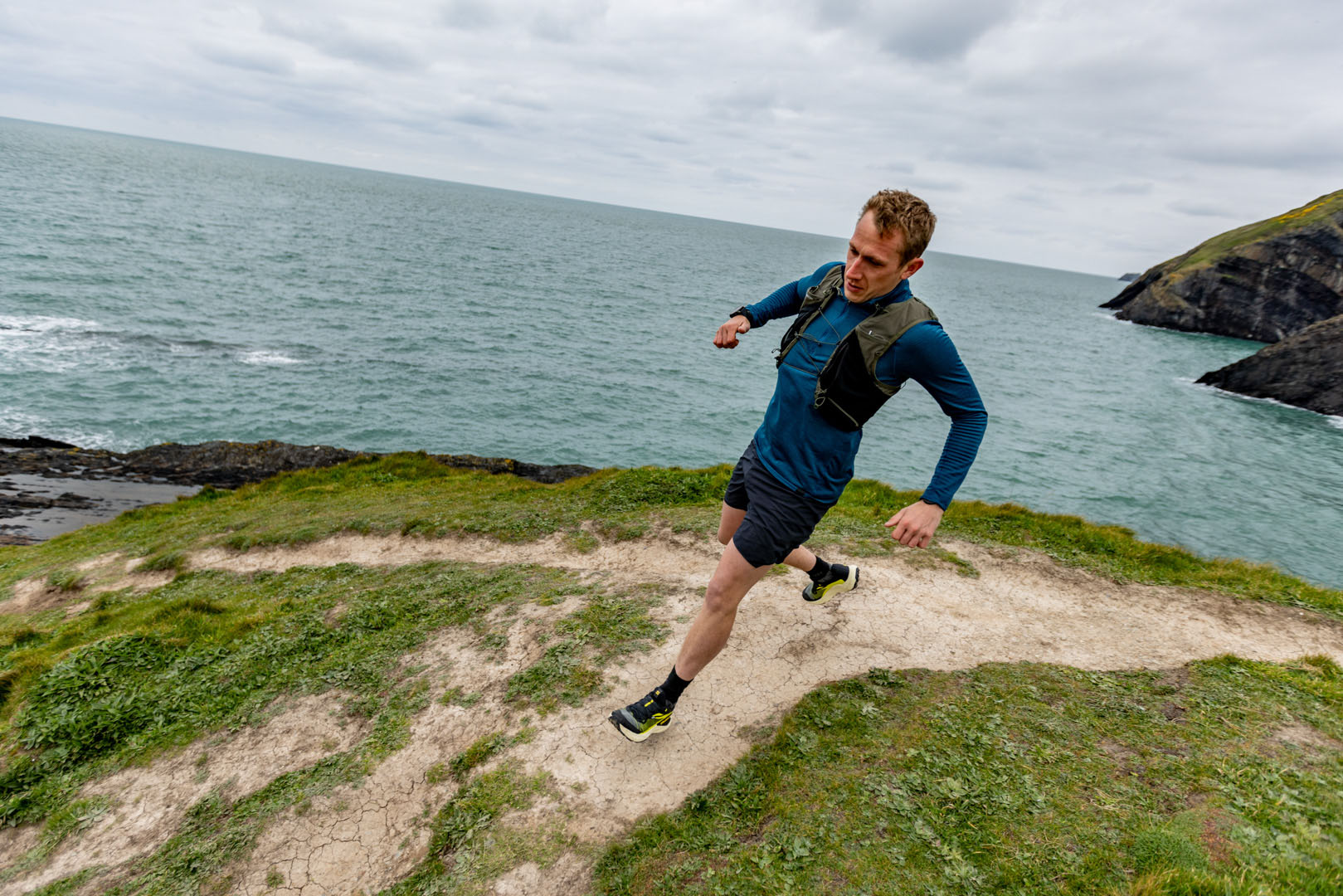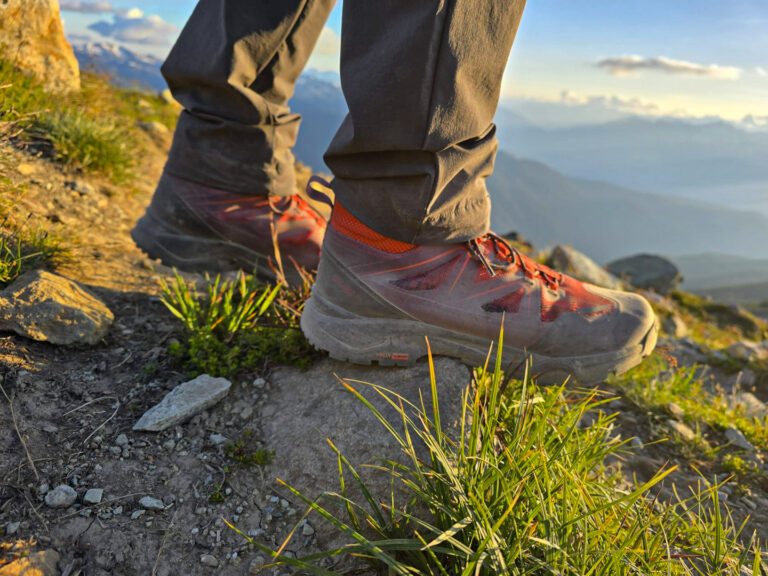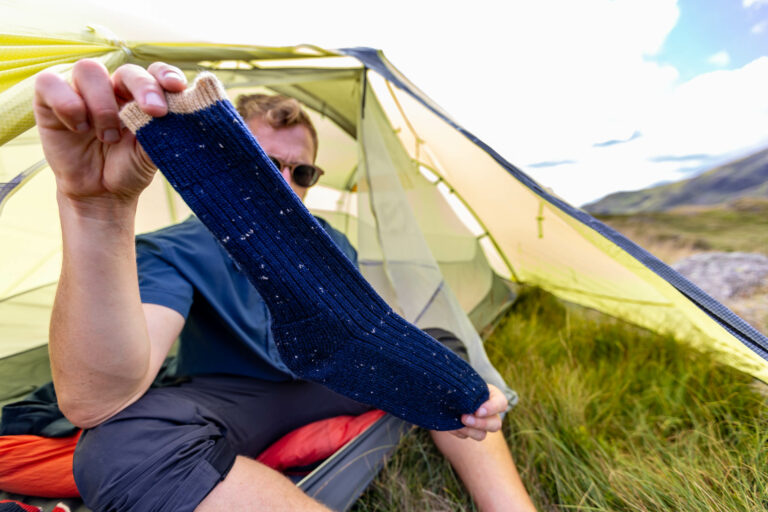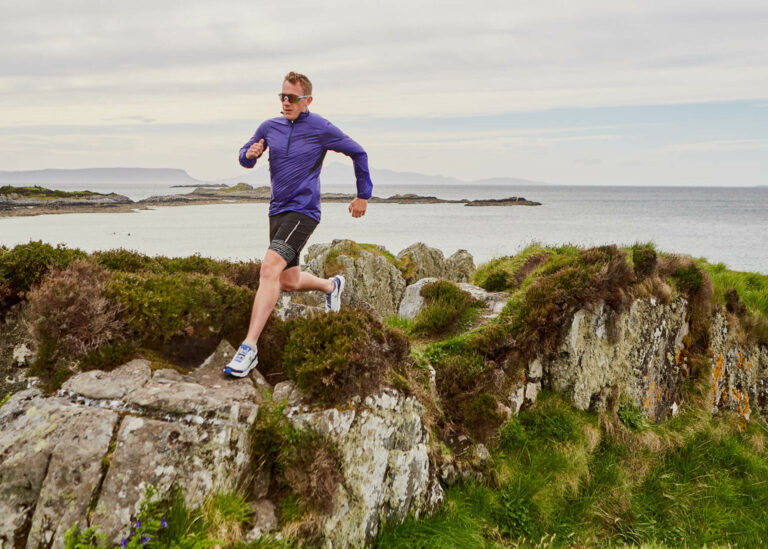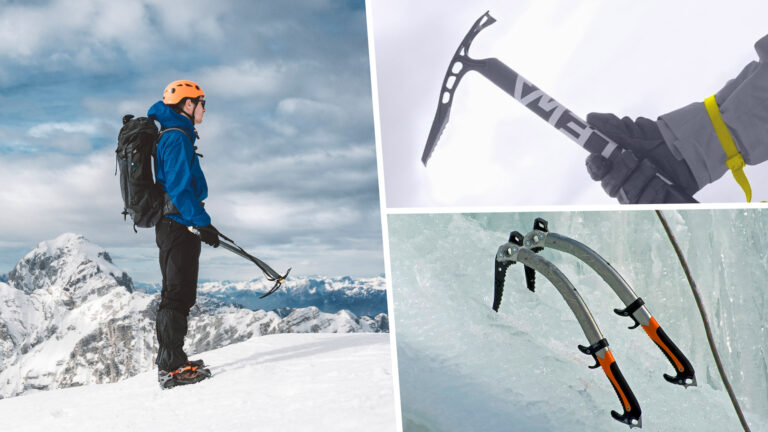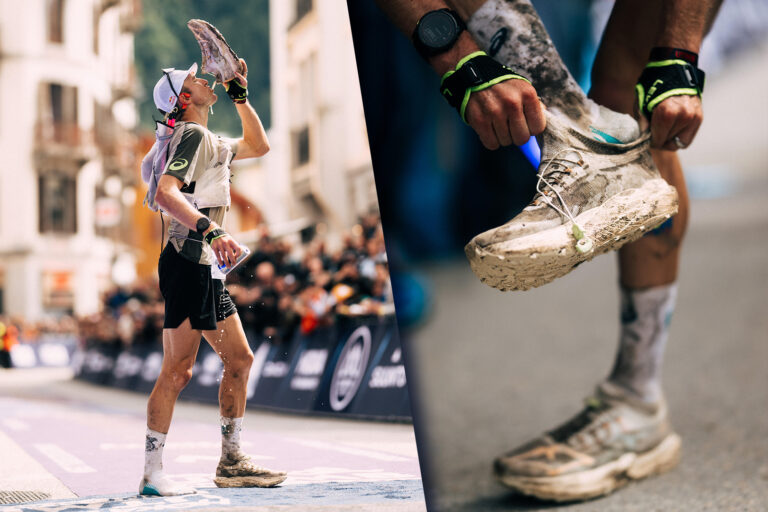If you’re wondering what the best trail running shoes you can buy are, you’re in the right place. We’ve conducted years worth of tests, taken part in ultras, marathons and weekly park runs in all of the latest models to get you the answer.
As chief reviewer here at Outdoors Magic, I ultimately had the final say on this list and I genuinely think that we’ve managed to come up with a totally comprehensive guide that not only highlights the best men’s trail running shoe overall, but that also picks out the best options to suit your needs, whether that’s a fast shoe to help you keep at the front of the pack on a trail half marathon, or a plush, cushioned shoe that is going to help your joints when you’ve been running over endless mountains during an ultra.
How We Tested Them
We’ve put every pair here through serious mileage in the environments they’re designed for. I personally was responsible for the majority of the testing, enduring long runs through the boggy terrain of Rannoch Moor in the Scottish Highlands, hard-packed mountain trails in the Lake District and just simple daily runs around my locality on the chalk trails of the Wiltshire Downs. As a rule, each pair of shoes we assess will have been run in for at least 50 miles before we start to record a verdict on them.
Looking for more trail running gear? We’ve compiled similar guides highlighting the best running shorts and best running socks. And for those interested in discovering lesser-known names in the trail world, take a look at our round-up of the best new and boutique running brands.
The Best Men’s Trail Running Shoes of 2025: The Result of Our Tests
In this test of a surprisingly diverse range of off-road running footwear, we’ve picked out the best pairs for different scenarios and conditions. The shoes here are all great but in different ways and we’d recommend them for different uses. Here are our category winners for the best running shoes for men:
- La Sportiva Mutant – Best Men’s Trail Running Shoe Overall
- Asics Trabuco Max 4 – Best for Light Trail / Door-to-Trail
- Arc’teryx Norvan LD4 – Best Technical Trail / Mountain Running Shoe for Men
- Nnormal Kjerag Brut – Best Men’s Trail Running Shoe for Muddy and Soft Ground
- Hoka Zinal 2 – Best Lightweight Racing Shoe for Trail Running
- Altra Olympus 5 – Best Men’s Ultra Distance Running Shoe
Editor’s Note: This article was updated in September 2025 to ensure that all of the products are still available for purchase. After much testing, the Asics Trabuco Max 4 was added in as the best shoe for light trail running, while the Altra Olympus 5 was chosen by our testers as the best ultra distance running shoe, replacing the Arc’teryx Sylan.
1. La Sportiva Mutant
Best men’s trail running shoe overall: this came out tops in our tests due to its all-round versatility.
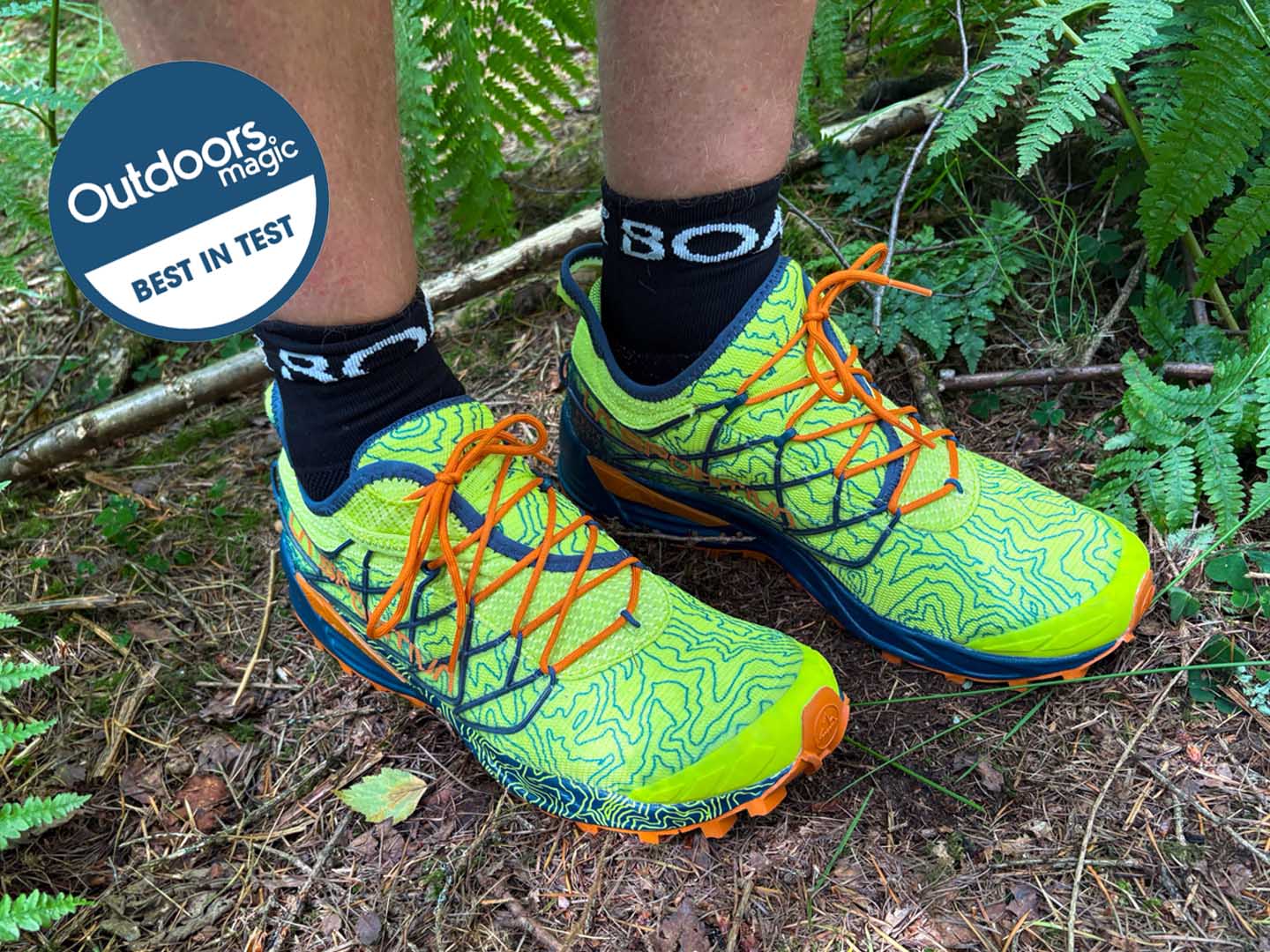
Price: £155
Weight: 320g
Key attributes: Sturdy, grippy, comfortable
Buy this if: You want a grippy shoe that can tackle all kinds of terrains, distances and scenarios
Don’t buy this if: You have wide feet or you like a highly cushioned shoe
Grip: 9/10. Cushioning: 7/10. Durability: 9/10. Protection: 8/10.
Overall rating: 9/10
A few years ago, we conducted a test to find the grippiest trail running shoes and it was the La Sportiva Mutant that came out on top. It wasn’t necessarily the grippiest we’ve tested (that award goes to the Nnormal Kjerag Brut) but it was the best shoe for grip on a range of different surfaces. It generally impressed us for its all-round offering too, and that assessment still holds. This is a shoe that members of our test team have been running in for years now, and they still hold it in extremely high regard. Quite simply, it is the best trail running shoe we’ve used.
Aside from the grip, one other aspect that stood out to us during our tests was the fit and feel of the upper. It’s unique design creates a very comfortable, secure and wrapping fit that fills you with a lot of confidence. The Mutant also strikes an excellent balance between durability, cushioning and weight. It feels light and fast but it also feels hardy and protective.
Related: The Fastest Shoes at UTMB
La Sportiva have made this specifically for mountain running but, from our experience, it’s the kind of shoe that has the versatility for all kinds of trail running. We’ve used it for multi-day fastpacking trips, for 50-mile ultras and for just day-to-day training runs, and it’s been right at home in each scenario.
A word on the fit: this is a close fit and is a touch narrow than average. Still, our testers found they were comfortable using it in their usual size.
Stack height: 26mm/16mm / Drop: 10mm / Lugs: 5mm.
Read our full La Sportiva Mutant review.
Buy the La Sportiva Mutant: £155 at Ellis-brigham.co.uk
2. Nnormal Kjerag Brut Trail
Best trail running shoe for muddy and soft ground.
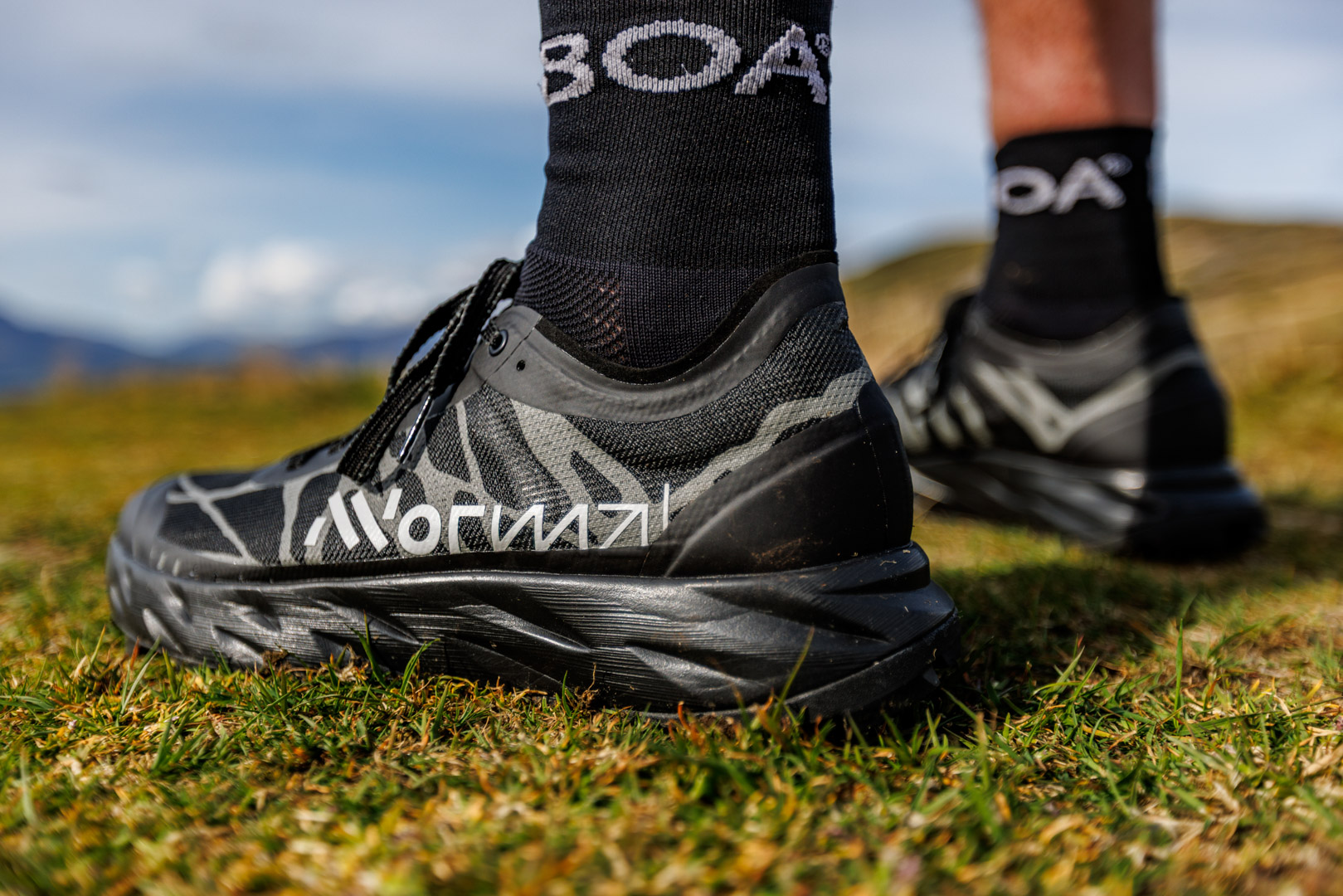
Price: £190
Weight: 230g
Key attributes: Very grippy on mud, lightweight, lots of drainage
Buy this if: Grip on muddy slopes is a total priority for you
Don’t buy this if: You like a cushioned shoe that’s relaxed at the toes or if you tend to run on hard trails
Grip: 10/10. Cushioning: 4/10. Durability: 8/10. Protection: 4/10.
Overall rating: 7/10
This shoe should have strong appeal for anyone looking for the right traits for fell running – that’s running that involves a lot of ascending and descending at speed on rough, wet and very slippery hill paths, and even on pathless terrain.
In our tests, it stood out for its lightweight and minimalist build. The upper has next to no padding, with the emphasis instead placed on drainage, ventilation and low weight. It’s a similar story underfoot, with no insole and only a modest amount of cushioning in the midsole.
Where the Kjerag Brut Trail doesn’t hold back is in its outsole. With huge 6.5mm lugs, this shoe is built for the muddiest runs. During testing on muddy winter moorland, it clung to just about every incline. It also surprised our testers with its performance on wet rock – not something typically expected from shoes with such aggressive tread. That said, it does start to slip a bit on stone slabs, due to the reduced surface contact.
All in all, we’ve found it to be a shoe best suited for wet and muddy runs with plenty of up and down – so generally, routes with soft ground and short to medium-length distances. It’s a bit too minimalist, with not enough cushioning or padding in the upper or midsole, to be comfortable for longer outings, especially on hard ground.
Stack height: 28.5 mm / 22.5 mm / Drop: 6 mm / Lug depth: 6.5 mm
Buy the Nnormal Kjerag Brut Trail: £172 at Alpinetrek.co.uk
3. Asics Trabuco Max 4
Selected as the best for light trail running and door-to-trail runs.
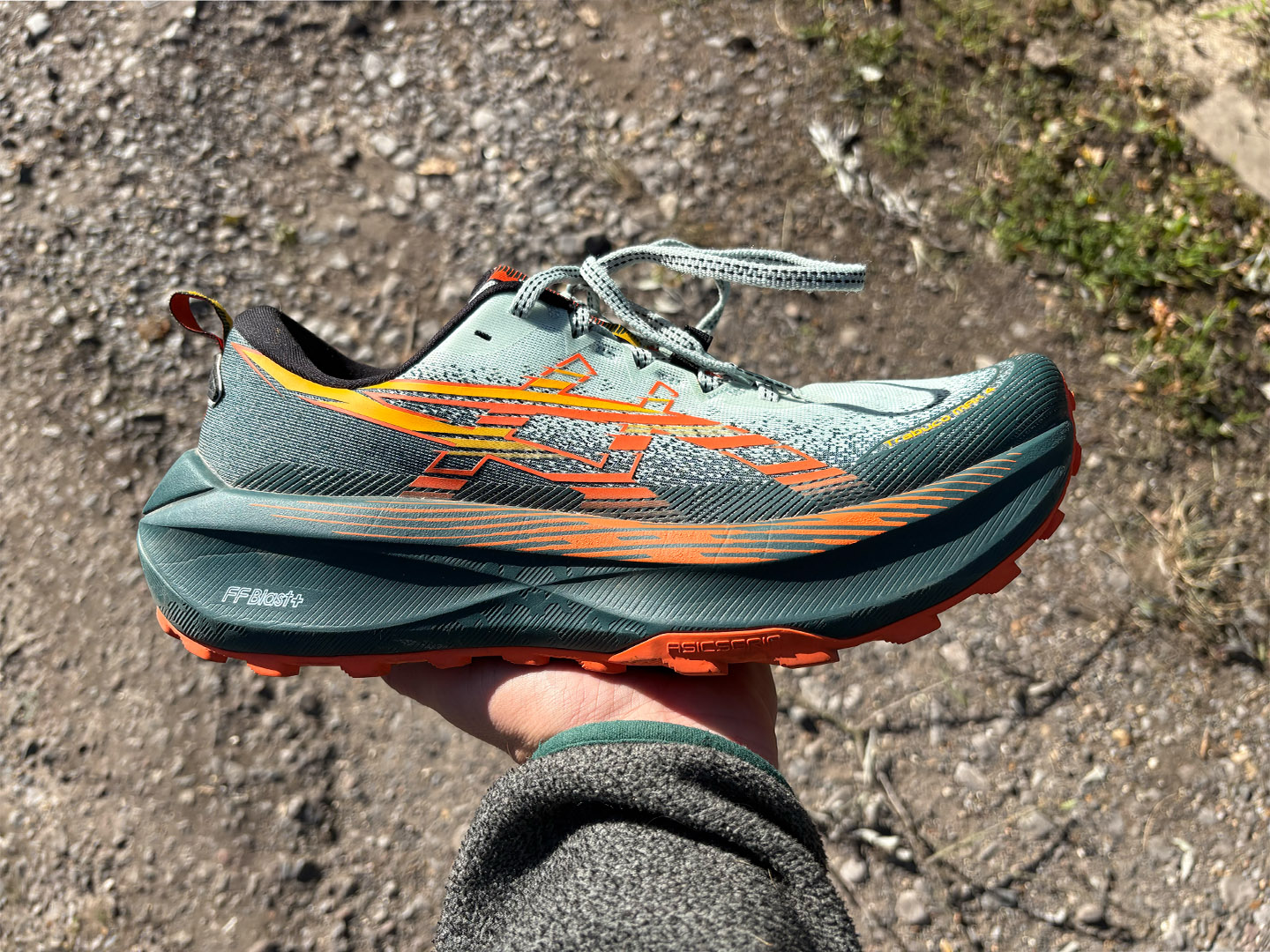
Price: £160
Weight: 336g
Key attributes: Cushioned, stable, versatile road-to-trail option
Buy this if: You want a high-cushion, stable shoe that’s comfortable over mixed terrain
Don’t buy this if: You mainly run on deep mud or want an ultra-light racing shoe
Grip: 7/10 · Cushioning: 9/10 · Durability: 8/10 · Protection: 8/10
Overall rating: 8/10
OM editor Will has been putting this through its paces. “The comfort was excellent right out of the box,” he said. “The engineered Jacquard mesh felt soft yet supportive, and the padding around the ankle and tongue gave a plush feel without being overdone. Fit was true to size, with a secure lockdown in the midfoot and heel, and enough room in the toe box for natural splay.”
Will also praised the cushioning and stability: “Despite the deep stack height, the midsole felt surprisingly stable. The FF Blast+ Eco foam has a good balance of firmness and comfort. I was impressed by the traction too – the outsole seems to handle compacted dirt, loose gravel, and wet tarmac really well. Even on mossy, slippery sections, I still felt reasonably confident. The 4mm lugs might not be aggressive enough for bogs or fell running, but for everyday trails they worked brilliantly.”
Overall, we’ve found that the ASICS Trabuco Max 4 is a dependable, cushioned, and versatile shoe that shines on long, mixed-terrain runs – perfect for runners who want one shoe to cover both road and trail.
Stack height: 41mm / 36mm · Drop: 5mm · Lug depth: 4mm.
Buy the ASICS Trabuco Max 4: £160 at Alpinetrek.co.uk
4. Arc’teryx Norvan LD 4
Chosen as the best technical trail / mountain running shoe.
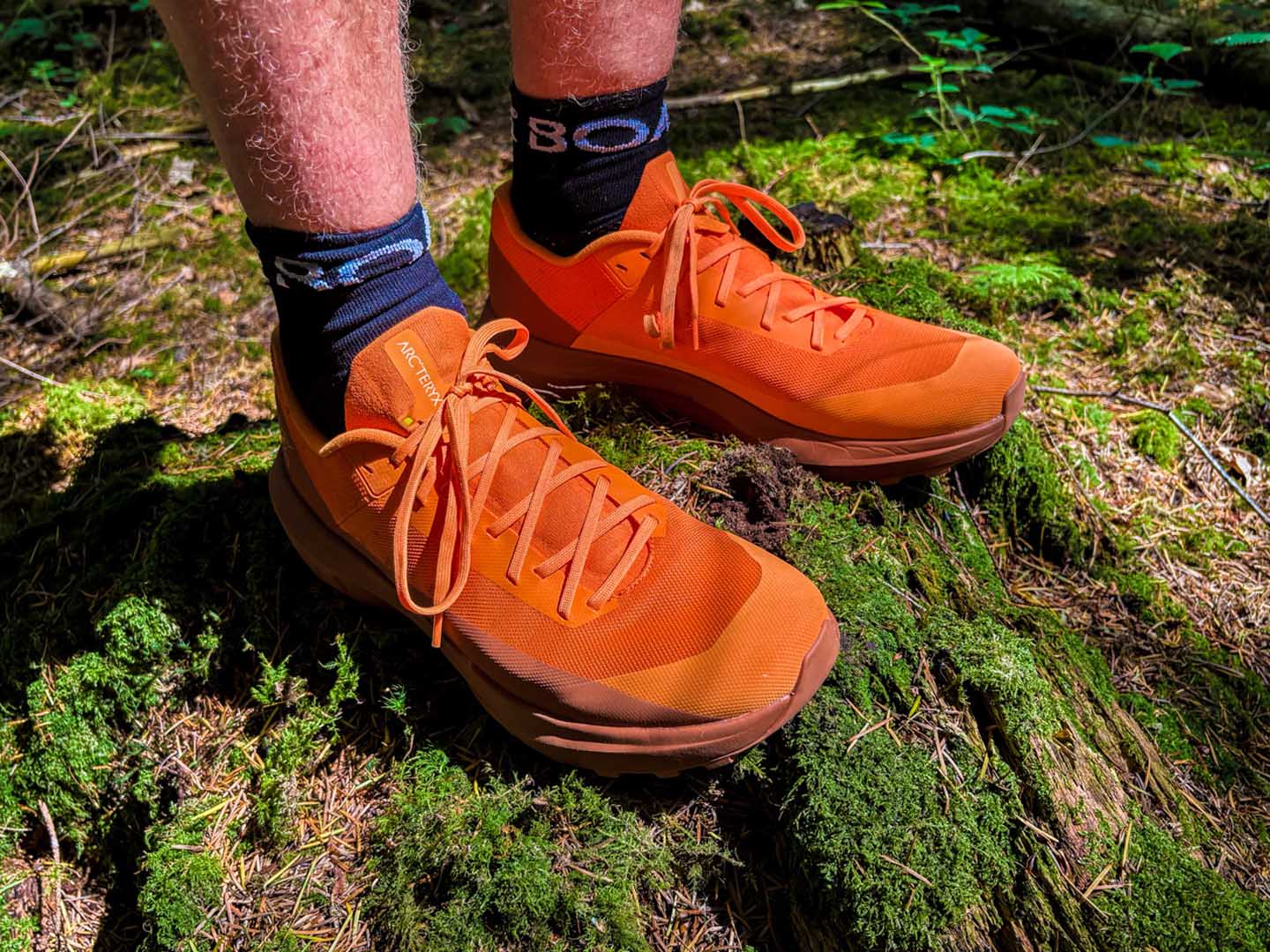
Price: £150
Weight: 270g
Key attributes: Versatile enough for a range of different types of running, grippy, durable, breathable
Buy this if: You want a versatile shoe for numerous scenarios and types of terrain
Don’t buy this if: You like maximal cushioning
Grip: 8/10. Cushioning: 8/10. Durability: 9/10. Protection: 9/10.
Overall rating: 9/10.
The “LD” in the name stands for long distance. This shoe is designed for mountain ultra-distance running, combining a fairly lightweight build with a thick heel and grippy outsole.
Our testers have used every iteration of the Norvan LD series, and this one is our favourite so far. What we’ve noticed is that while it’s built for lots of elevation over long distances, it’s actually a very versatile shoe. It may be intended for long-distance comfort, but it isn’t as cushioned or maximalist as other shoes in this category, such as the Hoka Mafate series or The North Face’s Summit Vectiv Pro 3. Instead, it feels agile, precise and responsive.
We’ve found it performs particularly well on rocky terrain, offering a stable platform that blocks out rocks and roots while still providing a good level of ground feel and proprioception.
Previous versions of the Norvan LD have proven durable, lasting for impressive mileage, and early signs for this version are equally promising.
Arc’teryx suggests that the Norvan LD 4 runs large, and many users report benefiting from going half a size down. In our testing, we used our testers’ usual sizes and didn’t encounter any issues. That said, it’s still worth trying a pair on in-store before committing to a purchase.
Stack height: 25 mm / 19 mm / Drop: 6 mm / Lug depth: 4 mm
Read our full Arc’teryx Norvan LD4 review.
Buy the Arc’teryx Norvan LD4: £138 at Alpinetrek.co.uk
5. Hoka Zinal 2
Best lightweight racing shoe for trail running.
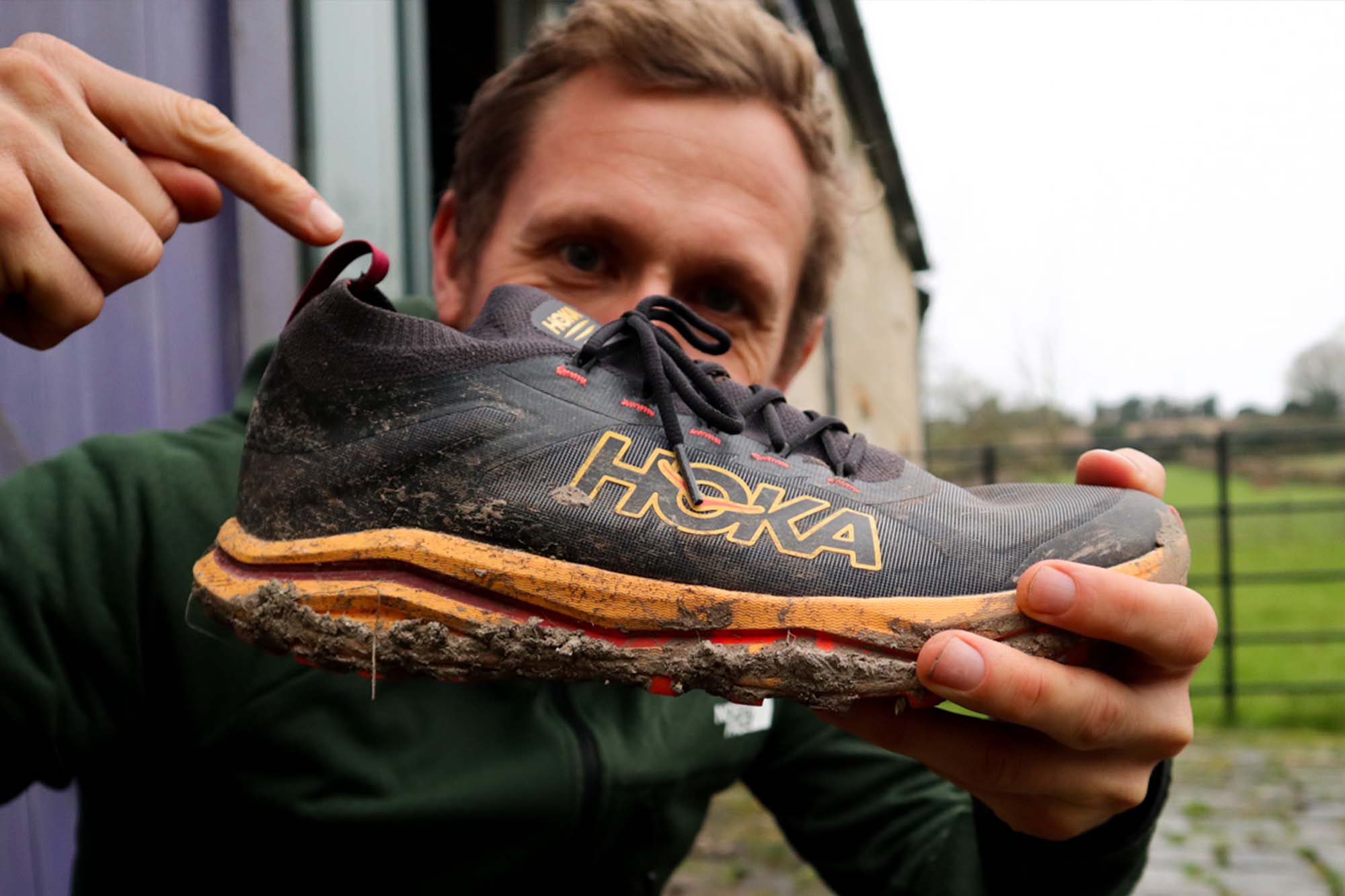
Price: £160
Weight: 227g
Key attributes: Light and fast feeling
Buy this if: You want a fell-running style shoe but one that isn’t too jarring on hard trails and road to trail transitions
Don’t buy this if: You have wide feet or you like a highly cushioned shoe
Grip: 9/10. Cushioning: 5/10. Durability: 8/0. Protection: 7/10.
Overall rating: 7/10.
This is a fast and light shoe that stood out in our tests for its agile and precise feel. It’s the kind of shoe that we found we could leap around in with confidence while on rocky trails. The toe is quite narrow and the fairly low stack height and neutral drop keeps you feeling well connected with the trail but without any discomfort. We found this was right at home on dry trails, particularly on dirt tracks, gravel or on rocky stuff. It had its shortcomings on very muddy and sloppy trails, with the lugs not quite aggressive enough for those conditions.

The cushioning is quite moderate – not plush but not minimalist either. As such, we found that this is a shoe that is great for fast pace running over short to medium-length distances. It was fine to wear for distances up to about 30km but if we were going beyond that, we’d want something with a touch more cushioning and room at the toe for foot splay. Ultimately, it gets our pick as the best lightweight trail shoes.
Stack height: 30 mm / 25 mm / Drop: 5 mm / Lug depth: 5 mm
Read our full Hoka Zinal 2 review.
Buy the Hoka Zinal 2: £112 at Ellis-brigham.com
6. Altra Olympus 275
Best ultra distance running shoe.
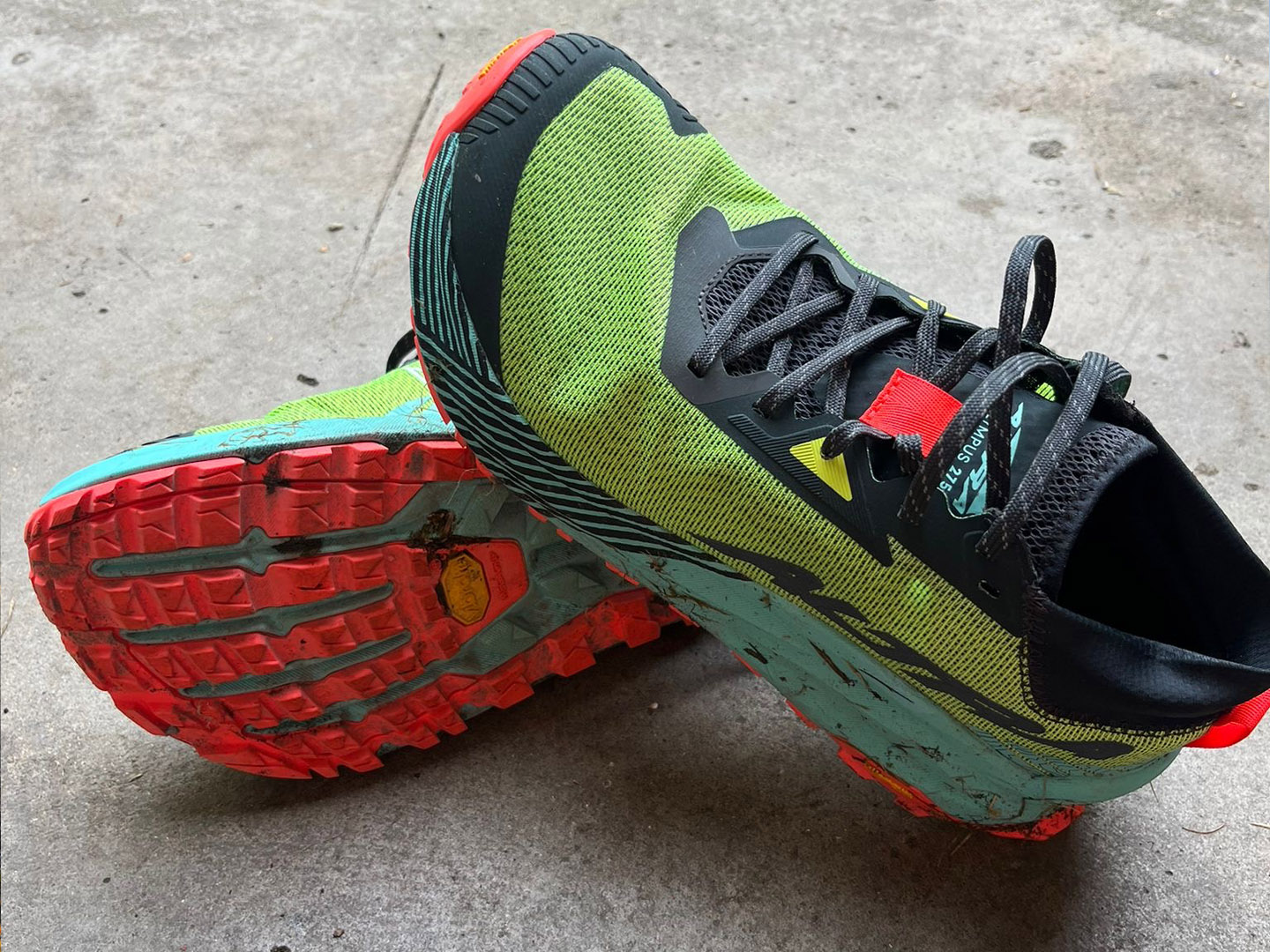
Price: £170
Weight: 275g
Key attributes: Soft cushioning, comfortable, secure wide fit
Buy this if: You want a plush, comfortable shoe that can handle long-distance trail runs
Don’t buy this if: You prefer a snappy, responsive shoe for racing or road-to-trail versatility
Grip: 9/10 · Cushioning: 9/10 · Durability: 8/10 · Protection: 8/10
Overall rating: 9/10
The best trail shoes for ultras? We think so. Our tester Stuart took the Altra Olympus 275 out for a number of runs across a mixture of light trail, rocky paths, grass, and road – undulating terrain that gave the shoe a thorough workout.
Stuart said: “The comfort right out of the box is superb. The wide fit is very accommodating but still locks my foot in securely, and I experienced no rubbing or hot spots during my runs. The grip is impressive too – even on slippery boardwalks and steep downhills, I felt completely confident.”
Stuart found the shoe felt surprisingly light and reasonably bouncy underfoot. He also highlighted the heel liner, which kept small stones out beautifully, a detail that makes a big difference on technical trails.
“My first kilometre in them felt slightly odd, but after that, the zero drop felt completely natural.,” said Stuart. “Going downhill was far superior to higher-drop shoes.” On the downside: “On road sections, the shoe feels a bit slow and ‘slappy’. I’d probably reach for something more responsive on race day.”
Overall, Stuart concluded that the Altra Olympus 275 is a superb, comfortable trail running shoe and a perfect ‘workhorse’ for long-distance training on mixed terrain.
Stack height: 33mm / 33mm · Drop: 0mm · Lug depth: 5mm
Buy the Altra Olympus 275 £170 at Altrarunning.eu.
7. Kiprun MT3 Trail
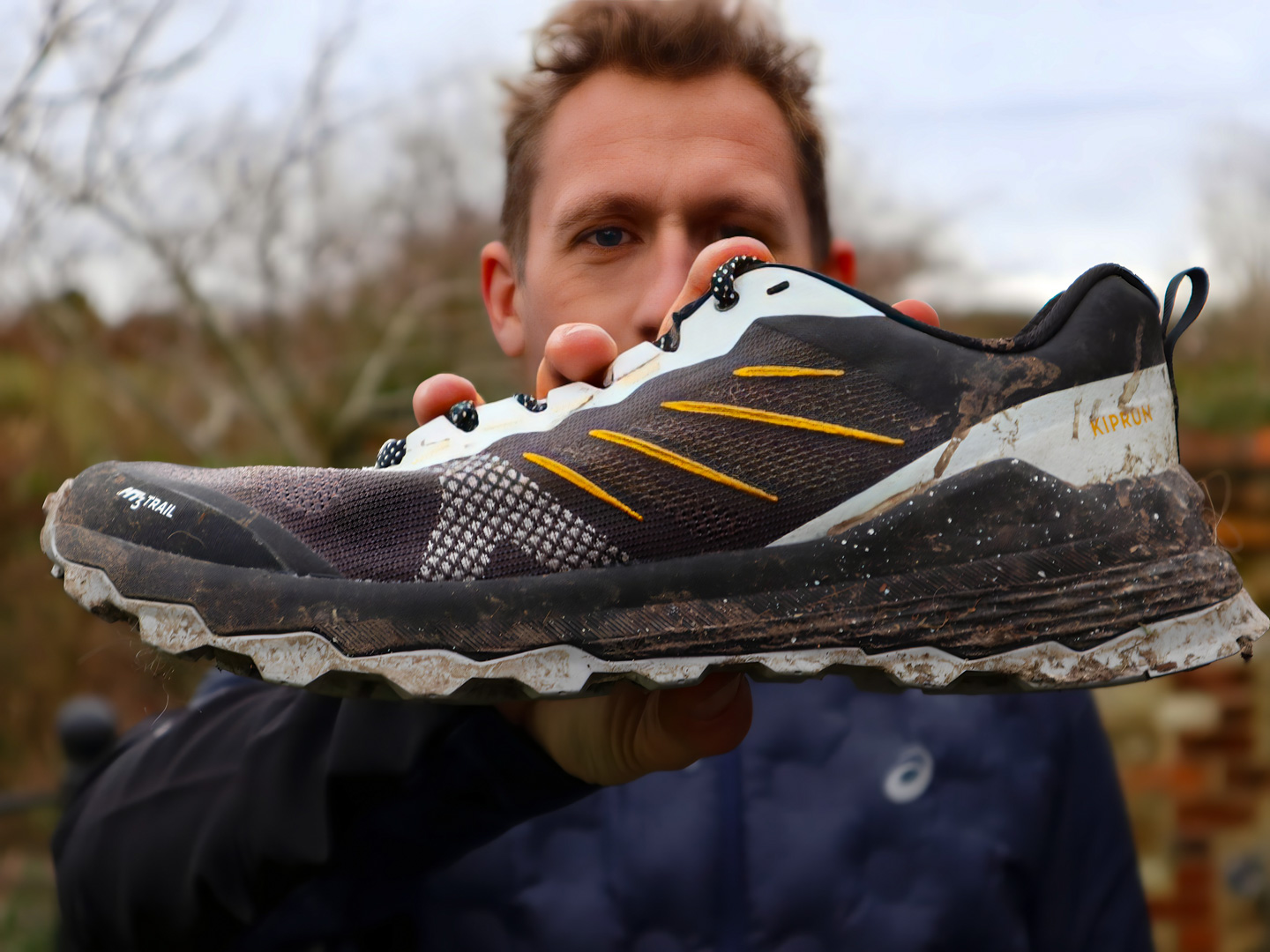
Price: £90
Weight: 310g
Key attributes: Good value, versatile, agile feeling, quite light
Buy this if: You want something that offers decent performance without the price tag
Don’t buy this if: You like a cushioned shoe and you like a protective upper
Grip: 7/10 Cushioning: 6/10. Durability: 8/10. Protection: 6/10
Overall rating: 7/10
We were impressed with the all-round versatility of this trail running shoe from Decathlon, especially given that it comes in at less than £100. We found the grip to be good on frozen trails and on wet and muddy bridleways too. It feels light and agile and we liked the reasonably wide platform that brought a lot of stability and confidence without feeling clunky. The upper is made from a mesh that’s breathable, durable and that shed water well when we wore the shoe through puddles. We also found that the laces held well. There’s a bit of room to the toe box; it’s not oversized but it gives a touch of space for your feet to splay when they start to swell.
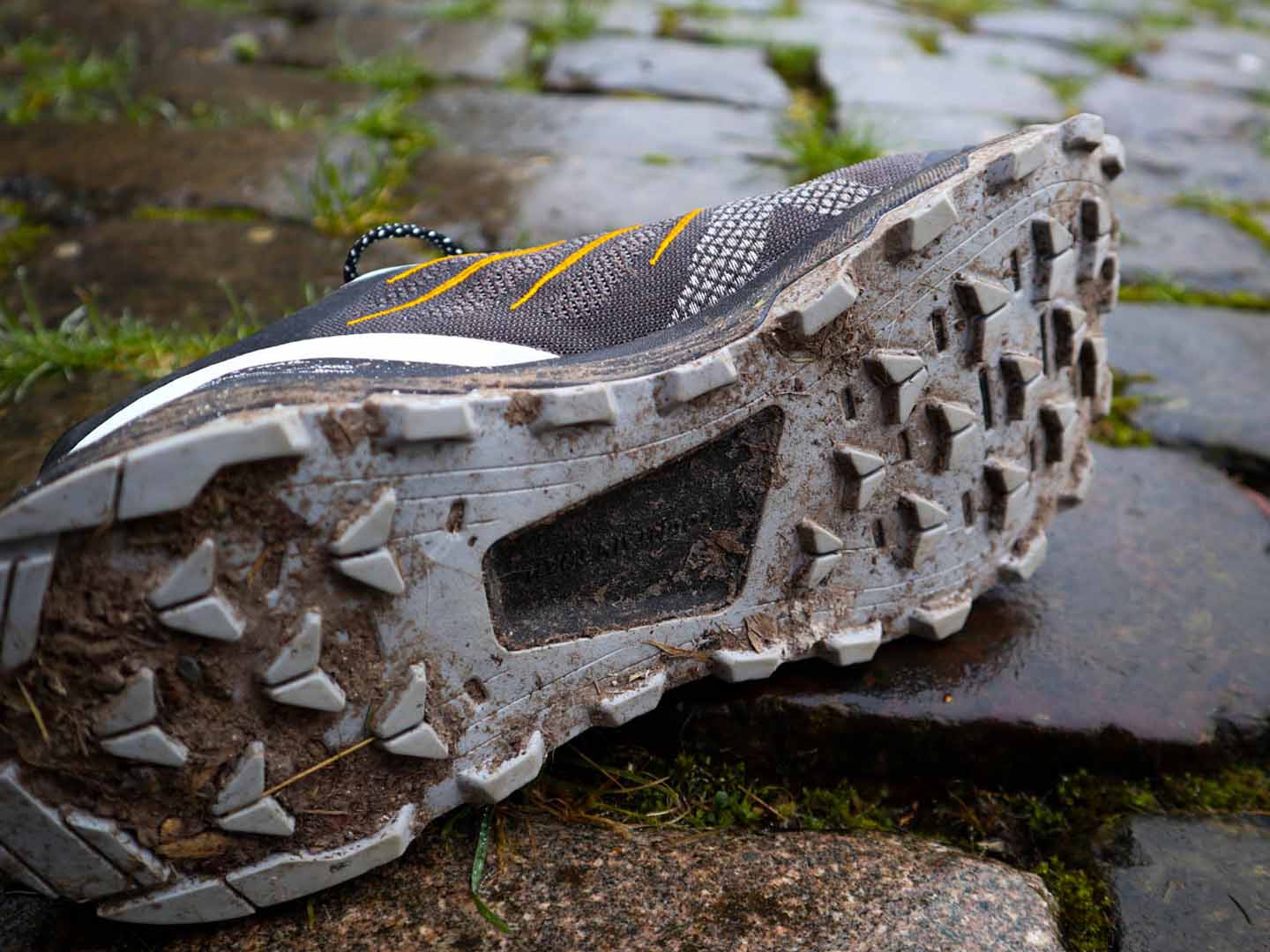
If you like a shoe with loads of cushioning then we’d advise looking elsewhere (start with the shoe immediately below, perhaps). We found that the Kiprun MT3 felt pretty solid underfoot, though it does still bring some shock absorption to the table. Overall, it’s the kind of shoe we’d happily wear from training runs and short to medium-distance trail runs that don’t involve too much road. For longer distances, we’d want something with a touch more softness at the midsole.
Stack: 26mm / 18 mm / Drop: 8mm / Lugs: 4mm
Read our full Kiprun MT3 Trail review.
Buy the Kiprun MT3 Trail: £75 at Decathlon.co.uk
8. The North Face Summit Vectiv Pro 3
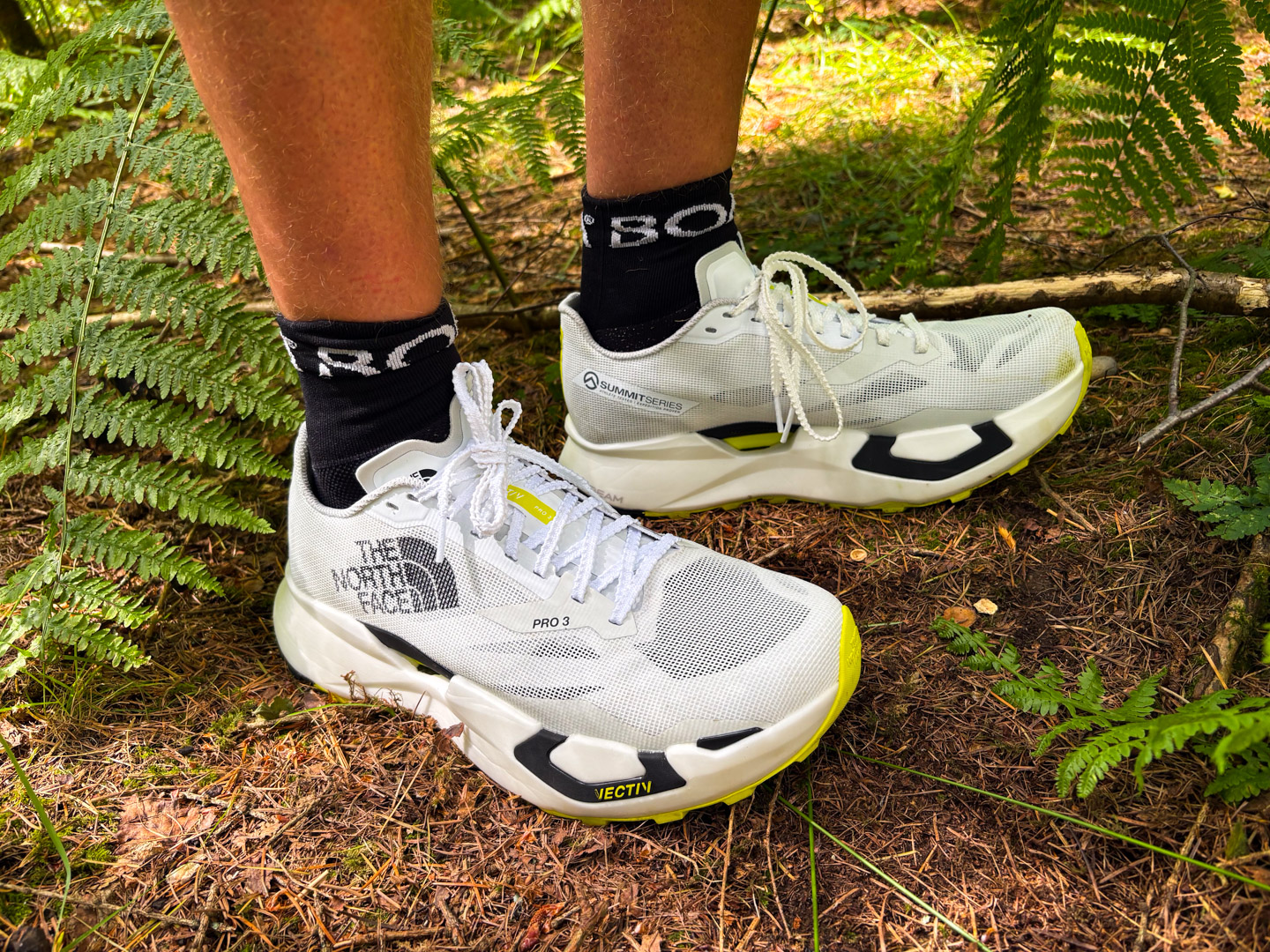
Price: £225
Weight: 294g
Key attributes: Huge amounts of cushioning, very fast feeling
Buy this if: You want something that will feel fast and comfortable over long distances
Don’t buy this if: You need a shoe for very uneven terrain
Grip: 8/10. Cushioning: 10/10. Durability: 7/10. Protection: 7/10.
Overall rating: 8/10
These are the plushest and most cushioned shoes in this round up – and potentially within the wider market. They also feature a carbon plate within the midsole and a highly pronounced rocker geometry. The result? Our testers found this to be a shoe that completely prioritises long-distance comfort. We found it performed excellently on fairly flat and easy-going trails, with the rocker providing a fast and boosted stride.
However, it felt a little ungainly and unstable on technical terrain, as the combination of the carbon plate and the tall midsole reduced overall precision.
The outsole, while not overly aggressive, provides decent grip on dirt tracks and lightly muddy trails. That said, we did find it reached its limits on very steep or heavily muddy terrain. The mesh upper, which features a seamless design, stood out to our testers by offering plenty of comfort, breathability and good drainage.
As for the fit, it is fairly standard with a good balance of comfort and precision.
Ultimately, this is a shoe designed for going fast and far on gravelly tracks, hard-packed surfaces and dry, well-defined dirt trails. Some runners may find it a little unbalanced on rocky terrain or during runs that involve traversing steep gradients. And don’t expect it to stay white for long. White is, to be honest, a strange colour choice for a trail shoe.
Stack height: 43 mm / 67 mm / Drop: 6 mm / Lug depth: 3.5 mm
Buy The North Face Summit Vectiv Pro 3: £202 at Ellis-brigham.com
9. Altra Lone Peak 9+
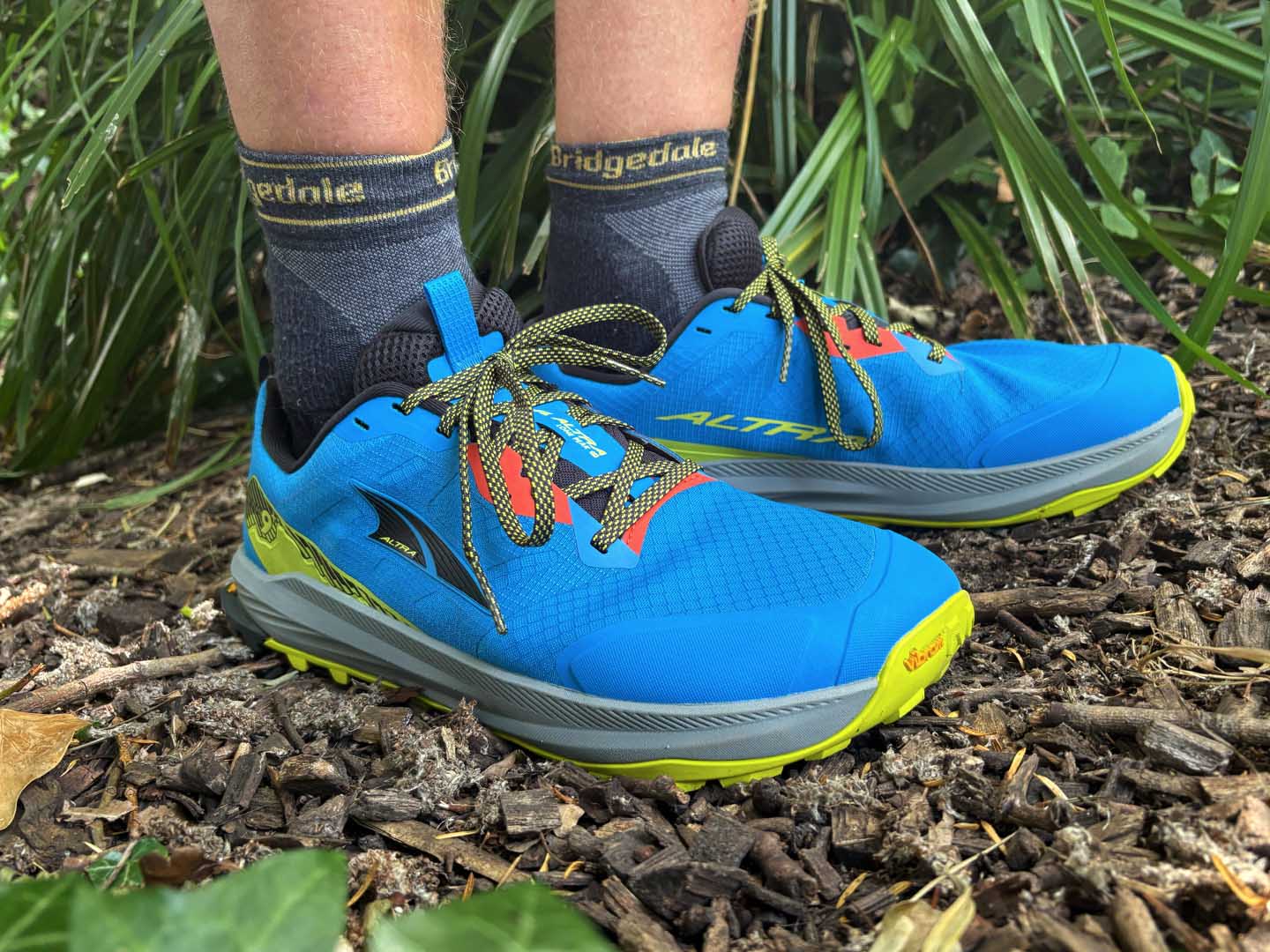
Price: £130
Weight: 327g
Key attributes: Wide toe box for long distance comfort, gaiter attachment points, grippy lugs
Buy this if: You like a shoe that’s wide at the toe and you like a neutral platform
Don’t buy this if: You like a precise and agile feeling shoe and lots of cushioning
Grip: 8/10. Cushioning: 5/10. Durability: 9/10. Protection: 8/10.
Overall rating: 8/10.
The Altra Lone Peak series has been around for years and has gained an almost cult-like following thanks to its unique fit and design features that cater specifically to ultra-long distances.
The standout feature of the Lone Peak 9, as with its predecessors, is the super-roomy toe box, designed to accommodate the foot swelling and splaying that naturally occur after covering big miles. This makes it a go-to choice for long-distance hikers. It has likely been the most popular shoe on both the Appalachian Trail and the Pacific Crest Trail for several seasons.
As a running shoe, the generous toe box is definitely an acquired taste. We appreciated the extra space during long days on relatively flat, well-defined trails, but found it felt a little too loose on more technical terrain, particularly when contouring along hillsides, where a snugger fit would have helped.
Cushioning is another area where the Lone Peak may not suit everyone. If you prefer a plush feel underfoot or a high stack height, this isn’t the shoe for you. The midsole is modest. It offers enough protection to block out rocks and roots and takes the edge off long days, but it’s far from luxurious.
Where the Lone Peak 9 really shines is in its grip. The lug pattern and outsole compound deliver impressive traction across varied terrain, from dry dirt to slick rock, making it a reliable option for anyone racking up serious mileage.
Stack height: 28 mm / 28 mm / Drop: 0 mm / Lug depth: 3.5 mm
Buy The Altra Lone Peak 9+: £130 at Ellis-brigham.com
10. Arc’teryx Sylan GTX
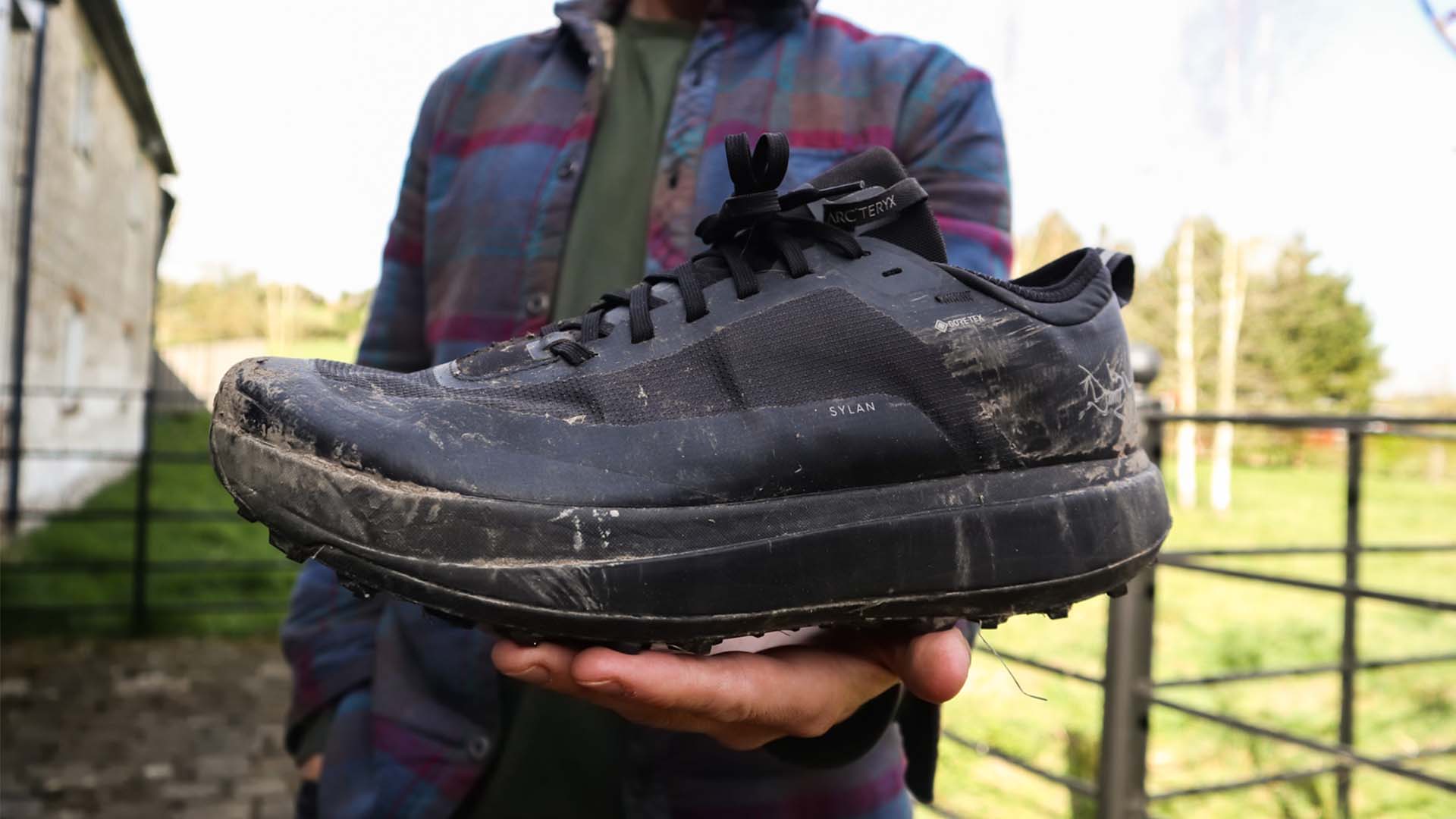
Price: £210
Weight: 327g
Key attributes: Comfy, create a smooth stride, durable
Buy this if: You want a shoe for running on groomed tracks with puddles
Don’t buy this if: You want something for ungroomed tracks or for very wet weather
Grip: 8/10. Cushioning: 9/10. Durability: 9/10. Protection: 9/10.
Overall rating: 9/10.
The thing that stood out the most when we tested the Sylan was the curved rocker geometry to the sole unit. It creates a feeling of forward propulsion when you’re running. This feeling is strange at first but it doesn’t take long to get used to. In the short term, this can save you energy, while it could help to prevent injuries from occurring in the longer run.
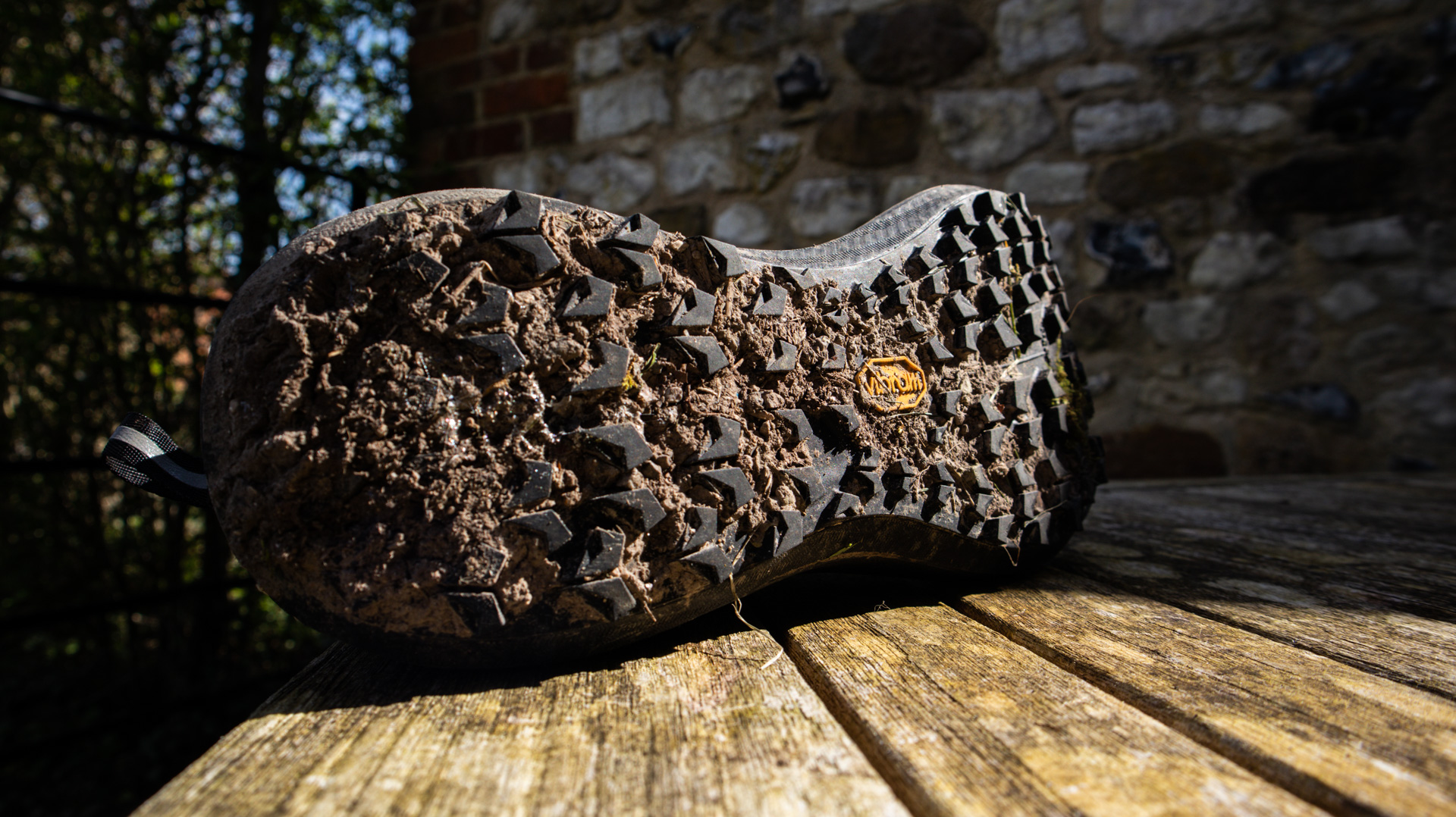
From our experience with this, we’d say it’s a great shoe for long runs at a slow pace – so things like mountain ultras. We did find it has its limitations on muddy trails, with the lugs not shedding as well as we would’ve liked. As such, we’d say it’s better for dry and hard packed trails than for soft, sloppy stuff.
The shoe pictured is the Gore-tex version which makes for a good hiking shoe. We’d recommend the non Gore-tex version for anyone looking for something for regular trail running.
Read our full Arc’teryx Sylan GTX review.
Stack height: 28mm / 22mm / Drop: 6mm / Lug depth: 3.5mm
Buy the Arc’teryx Sylan GTX: £210 at Arcteryx.com
11. Asics Metafuji Trail
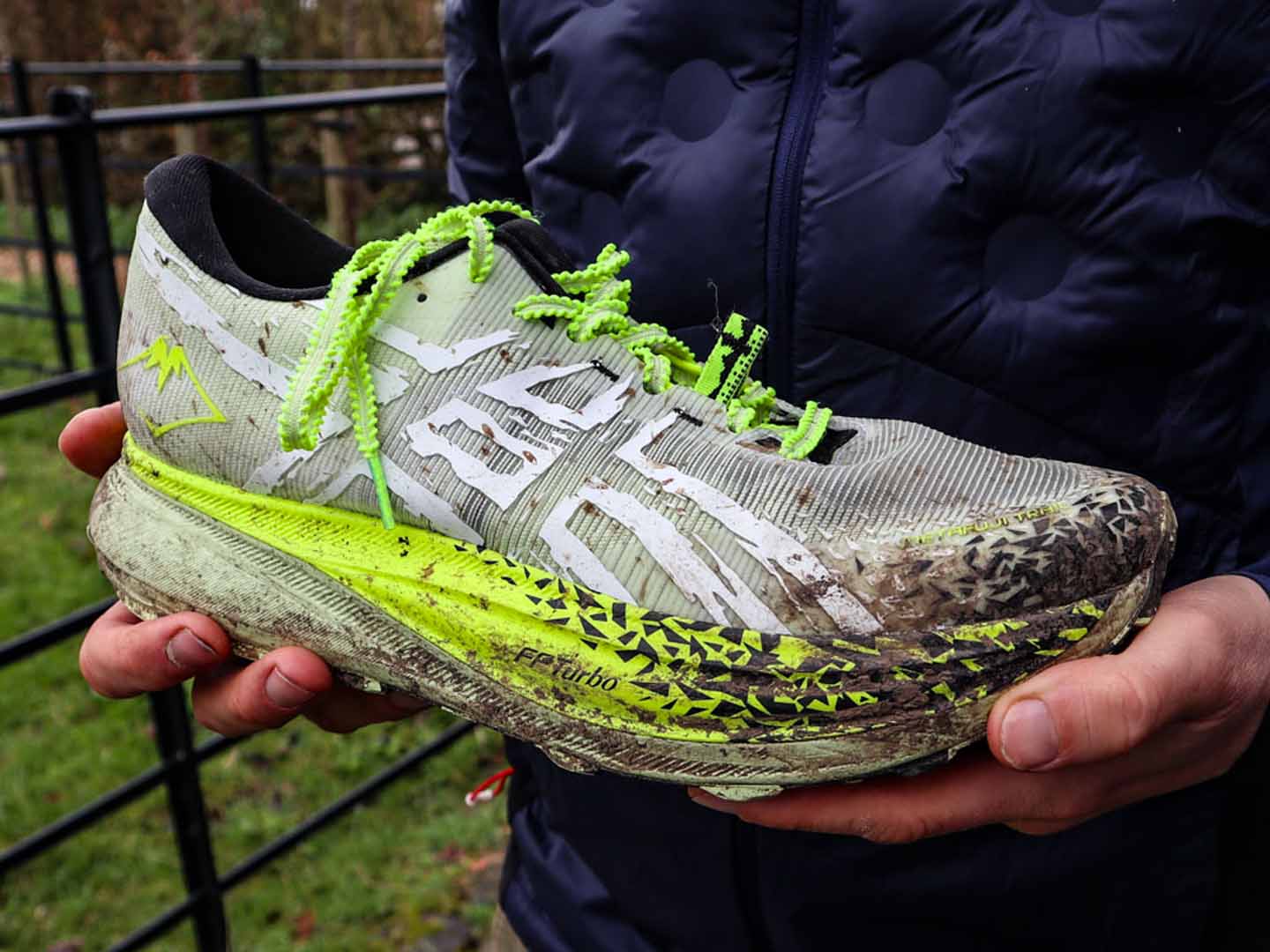
Price: £220
Weight: 260g
Key attributes: Fast-feeling, light, carbon-plated
Buy this if: You’re looking for a very fast, cushioned shoe for long distances on groomed trails.
Don’t buy this if: You want something that can handle rocky, technical trails
Grip: 7/10. Cushioning: 10/10. Durability: 7/10. Protection: 8/10.
Overall rating: 7/10.
This new shoe for Spring/Summer 2025 from Asics is pretty ‘out there’ in its design. With its carbon plate, high stack and bucket loads of springy cushioning, we found this is a shoe that’s all-in on speed. In our tests, we found it to excel on gravel bridleways, hard-packed trails and trail runs with large sections of road. We did find it to be a little too high and unstable on technical trails with lots of twists and turns, however. It has some bite on slippery trails but you’ll be better off with something with deeper lugs if an aggressive grip is your priority.
In one of our tests, we used it on a 13km night time trail race in France which had a constant fast pace and a mix of forest trails, road and pavement. Its plush cushioning and shock absorption, smooth forward propulsion, lightweight build and grippy outsole made it the perfect tool for the job.
Stack height: 45 mm / 40 mm / Drop: 5 mm / Lug depth: 4.5 mm
Buy the Asics Metafuji Trail: £220 at Runnersneed.com
12. Salomon Genesis
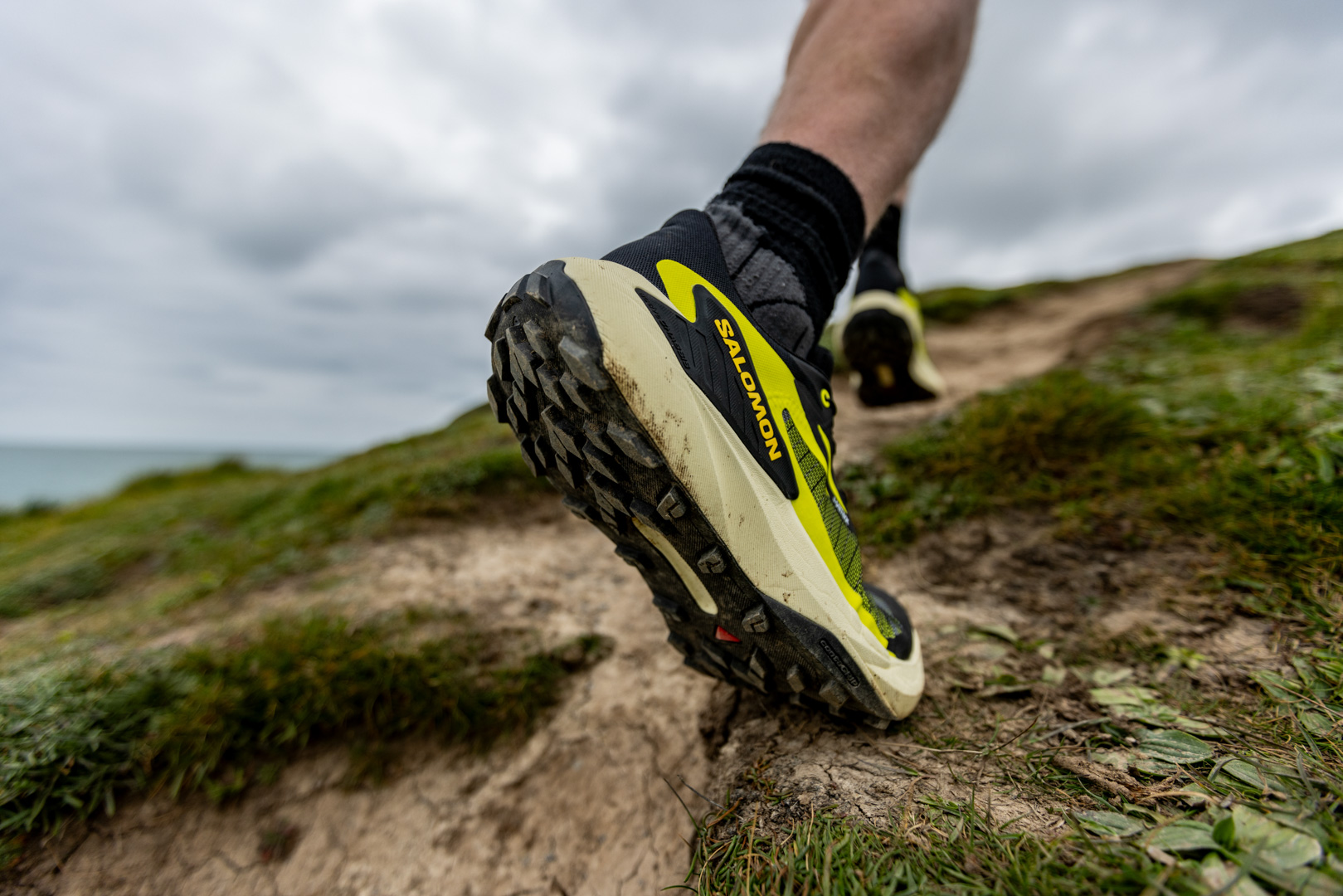
Price: £140
Weight: 276g
Key attributes: Good cushioning and flex, handy speed lacing
Buy this if: You want a grippy shoe that can tackle all kinds of terrains, distances and scenarios
Don’t buy this if: You like a wide toe.
Grip: 8/10. Cushioning: 8/10. Durability: 8/10. Protection: 8/10.
Overall rating: 8/10.
These trail running shoes strike all the right balances – to the point where we’d call them an everyman option. The fit is fairly average, the cushioning is mid level, the grip’s mid level and the weight’s mid level too.
While they’re not actually as cushioned as they look, we found these were still very comfortable to run in, be that on soft or hard surfaces. We loved how convenient and reliable the speed lacing was too.
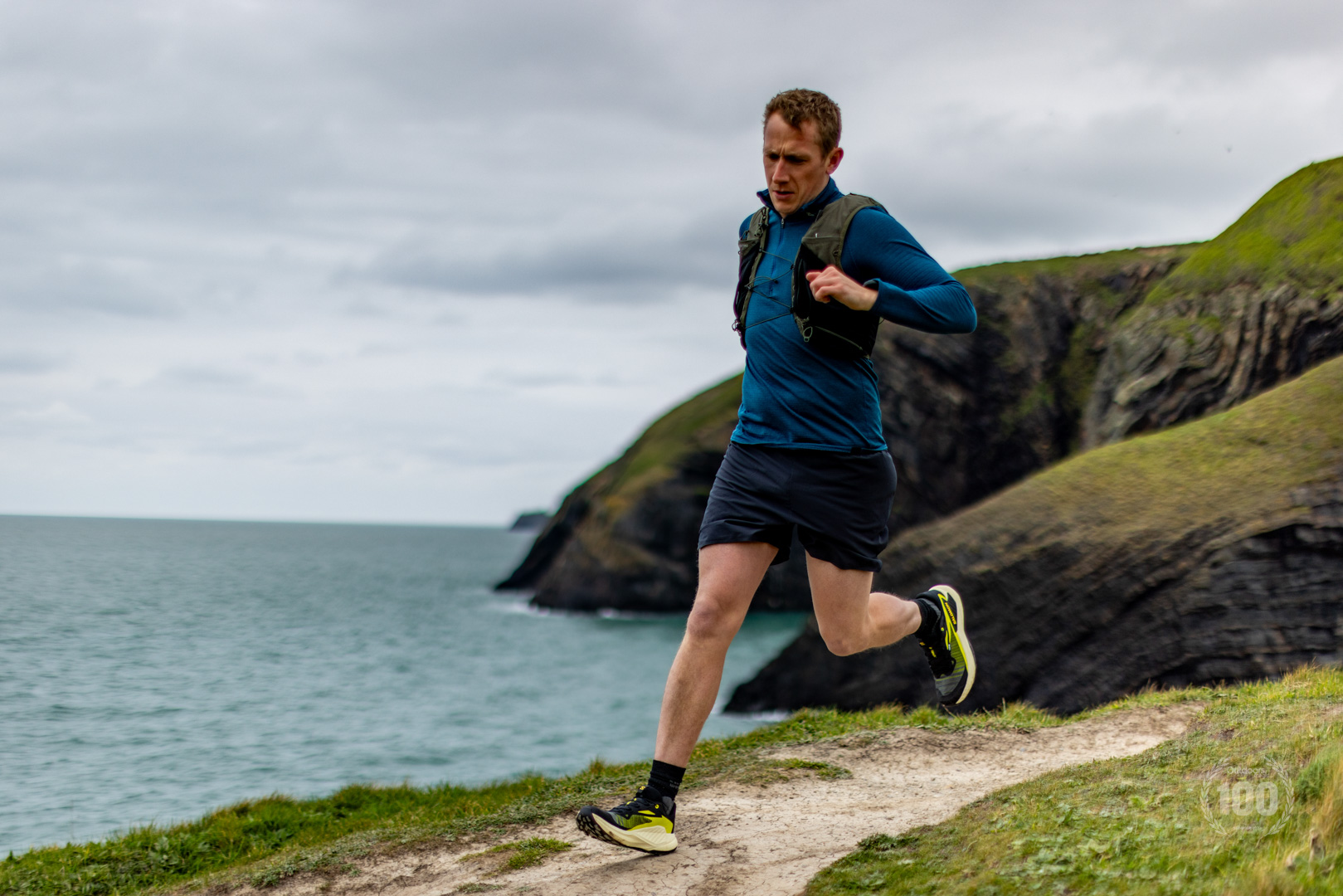
On mud, they offered good traction and shed away mud very well and the gusseted tongue kept out debris nicely. We do have some concerns over the long term durability of the outsole however, and that’s because on roads the rubber does feel quite soft and vulnerable to being worn down.
Still, these have landed as a firm favourite within our team and we’d consider them a worthwhile investment, especially for anyone looking for a shoe for all kinds of trails and distances.
Stack height: 34mm / Drop: 8mm / Lugs: 4.5mm
Selected for our Outdoor 100 gear of the year guide. Read our full Salomon Genesis review.
Buy the Salomon Genesis: £140 at Ellis-brigham.co.uk
13. Inov-8 Mudtalon Speed
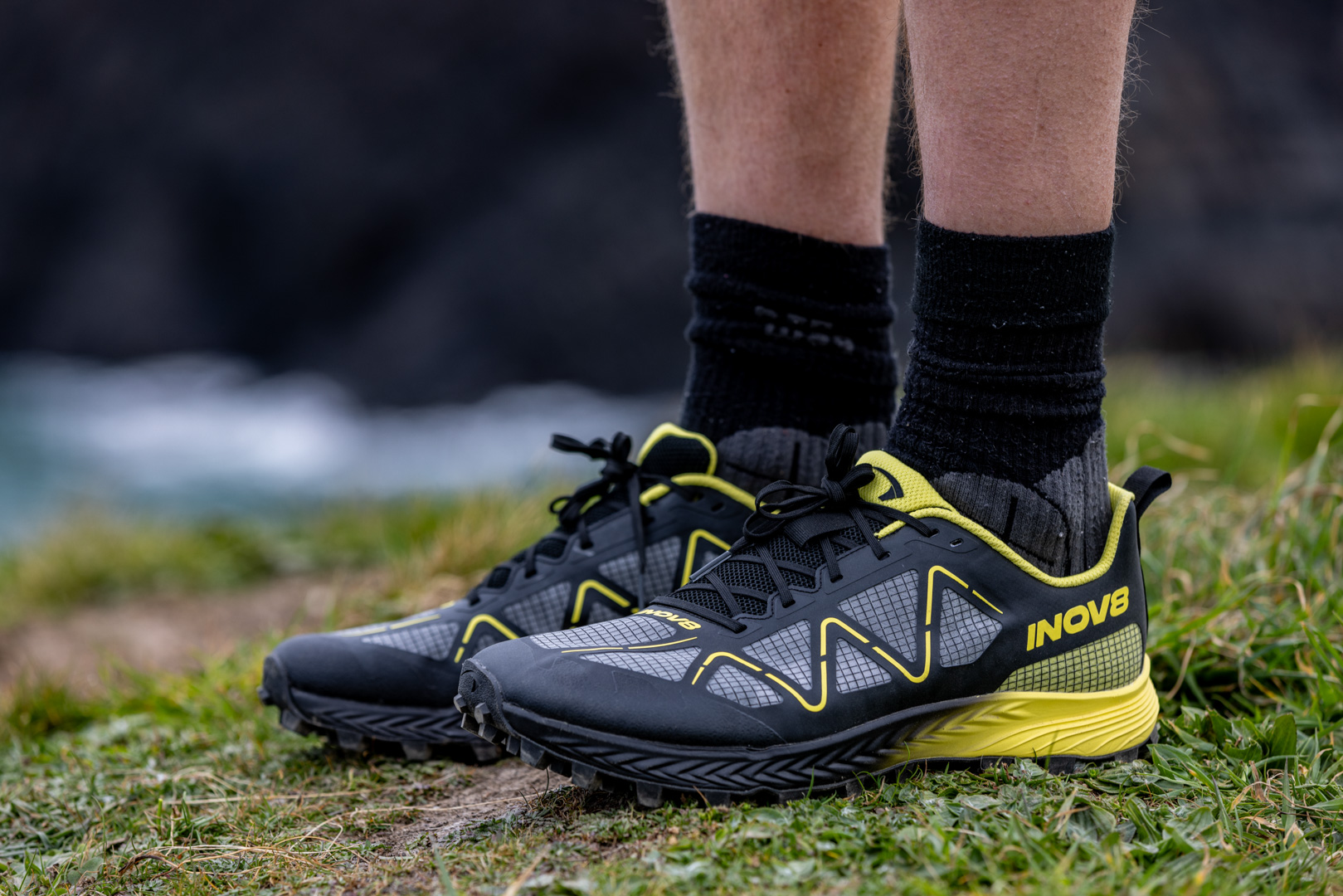
Price: £130
Weight: 260g
Key attributes: Lots of grip, very lightweight
Buy this if: You want something that can grip reliably on muddy inclines
Don’t buy this if: Cushioning is important to you
Grip: 10/10. Cushioning: 3/10. Durability: 8/10. Protection: 6/10.
Overall rating: 7/10.
Trail running shoes really do not get grippier than this. The Mudtalon is a seriously aggressive shoe design for the sloppiest of slopes boasting lugs that are a whopping 8mm in depth. For perspective, most trail running shoes have lugs that are around 4 to 5mm deep.
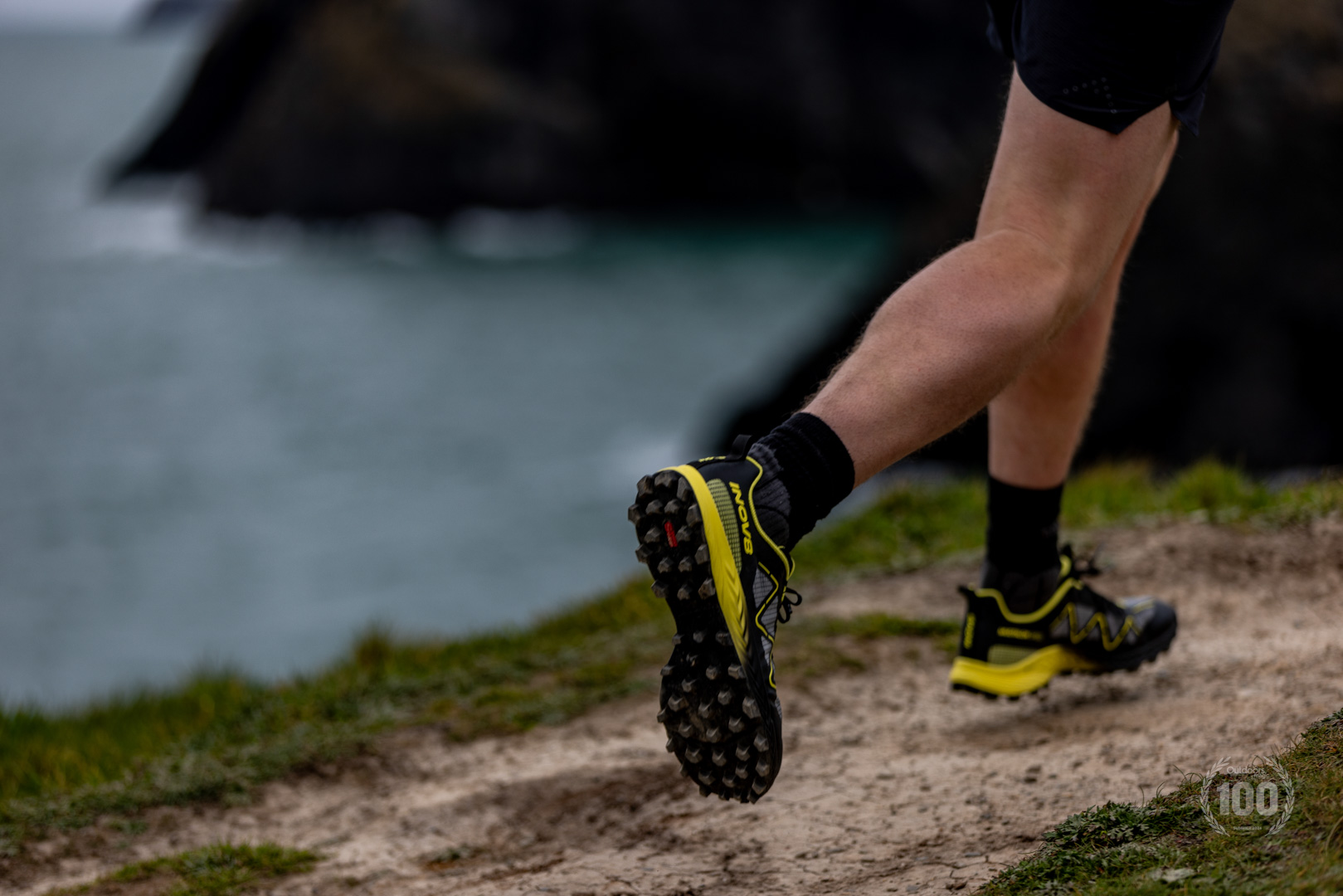
It’s a shoe that’s designed specifically for fell running, so you’ve got essentially a minimalist lightweight upper, light cushioning and then a very rugged outsole that’s designed to not only grip hard into mud but to shed it away too. In our tests, we found it did just that.
It comes in a narrow or wide fit. We tried the wide version which did feel very spacious at the toes but not to the point where our feet were sliding about. If you have narrow feet or you want a precise shoe for fast ascents then the narrow version should work best for you but if you want something that feels comfortable over longer distances or simply have wide feet then, you guessed it, opt for the wide fit.
Stack height: 11mm / Drop: 4mm / Lugs: 8mm
Selected for our Outdoor 100 guide. Read our full Inov-8 Mudtalon Speed review.
Buy the Inov-8 Mudtalon Speed: £78 at Ellis-brigham.co.uk
14. Salomon Vision Trail Shoe
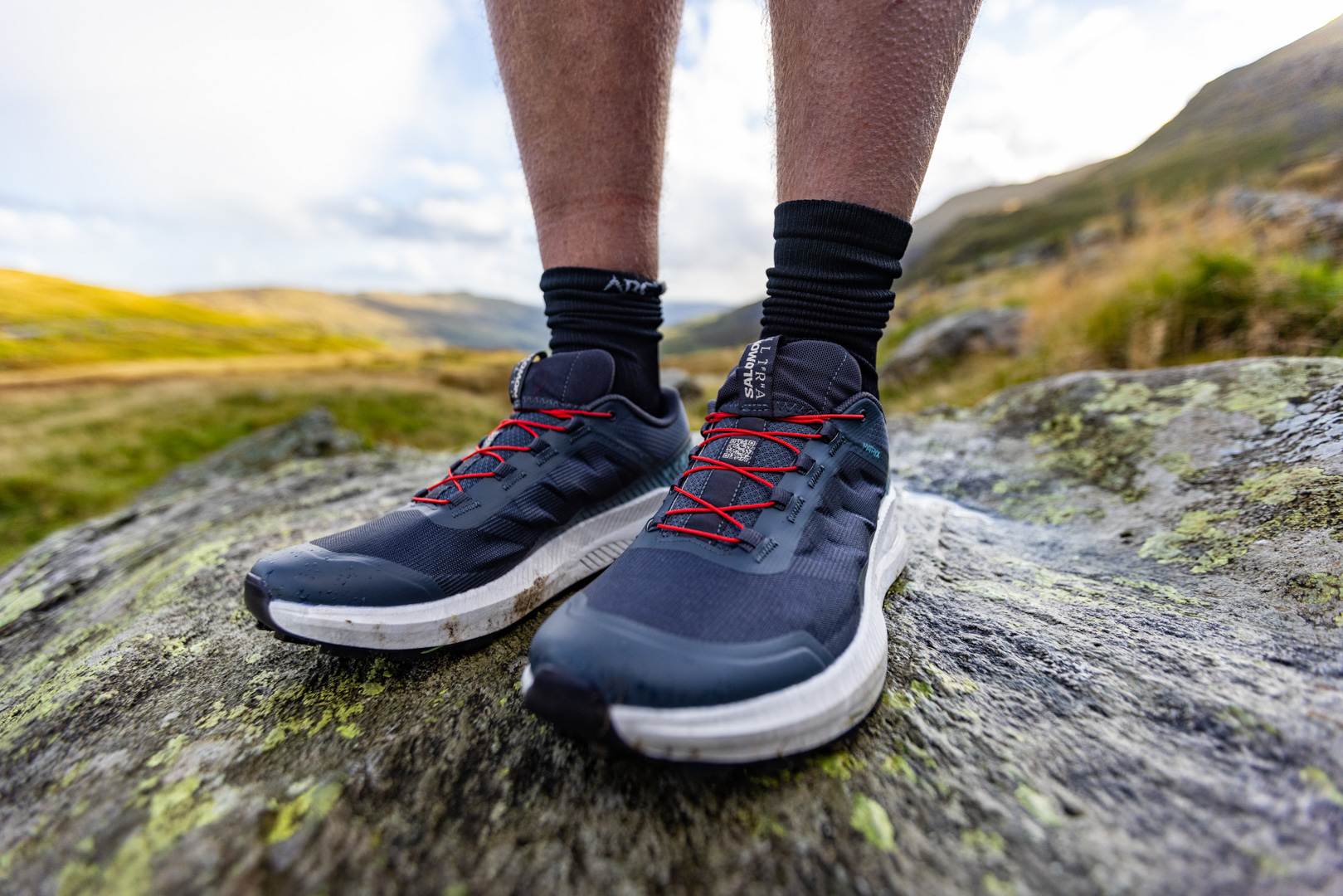
Price: £150
Weight: 300g
Key attributes: Durable upper, recyclable, versatile
Buy this if: You want a grippy shoe that can tackle all kinds of terrains, distances and scenarios
Don’t buy this if: You have wide feet or you like a highly cushioned shoe
Grip: 8/10. Cushioning: 8/10. Durability: 8/10. Protection: 8/10.
Overall rating: 8/10.
The Salomon Vision is a trail running shoe that’s been designed to be fully recycled at the end of its life. Each pair comes with a QR code printed on the tongue. Scan that and it takes you to a landing page where you’ll be presented with a pre-paid shipping label which you can use to send your shoes back to Salomon. Once they’ve been received, they’ll separate the upper and the sole and ensure that the materials get recycled into new raw materials that can be used in other products. Pretty cool huh.
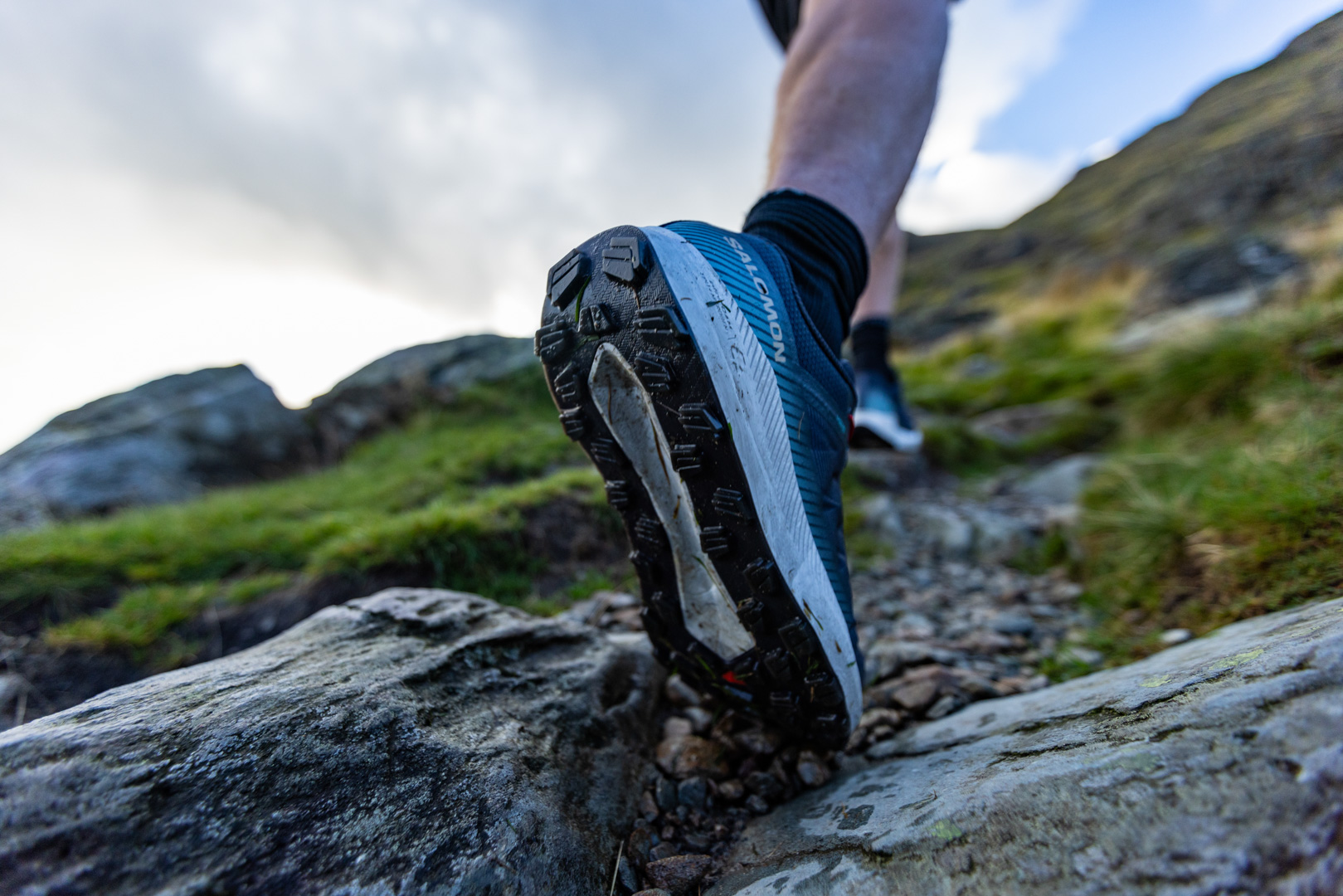
We’ve been using the Salomon Visions on some UK trails over the last month and have found that they felt comfortable and ready to roll right out of the box. The Contragrip rubber gripped well on hard packed but at times slimy chalk trails and it was fine for road to trail transitions. The lugs are 4.5mm in depth, which makes the Vision quite versatile but there are definitely more aggressive shoes out there.
Comfortable and a reliable performer, this is a pretty versatile shoe that we’ve enjoyed running in. If you like a light and fast shoe or one with super aggressive grip, look elsewhere, but if you want a solid performer that you can sling on for all your training runs – or for casual wear – we think you’ll like this.
Stack height: 24mm / 33mm Drop: 8mm / Lug depth: 4.5mm
Read our full Salomon Vision review.
Buy the Salomon Vision: £150 at Salomon.com
What to Look for in a Trail Running Shoe: Our Buyer’s Guide
The first thing to be looking out for on a trail shoe is the grip. In many cases, particularly in places where it’s muddy and wet, you’ll want as near to football boots as you can find. That being said, if you’re trail running on dry and dusty paths, overly aggressive lugs might be a hindrance.
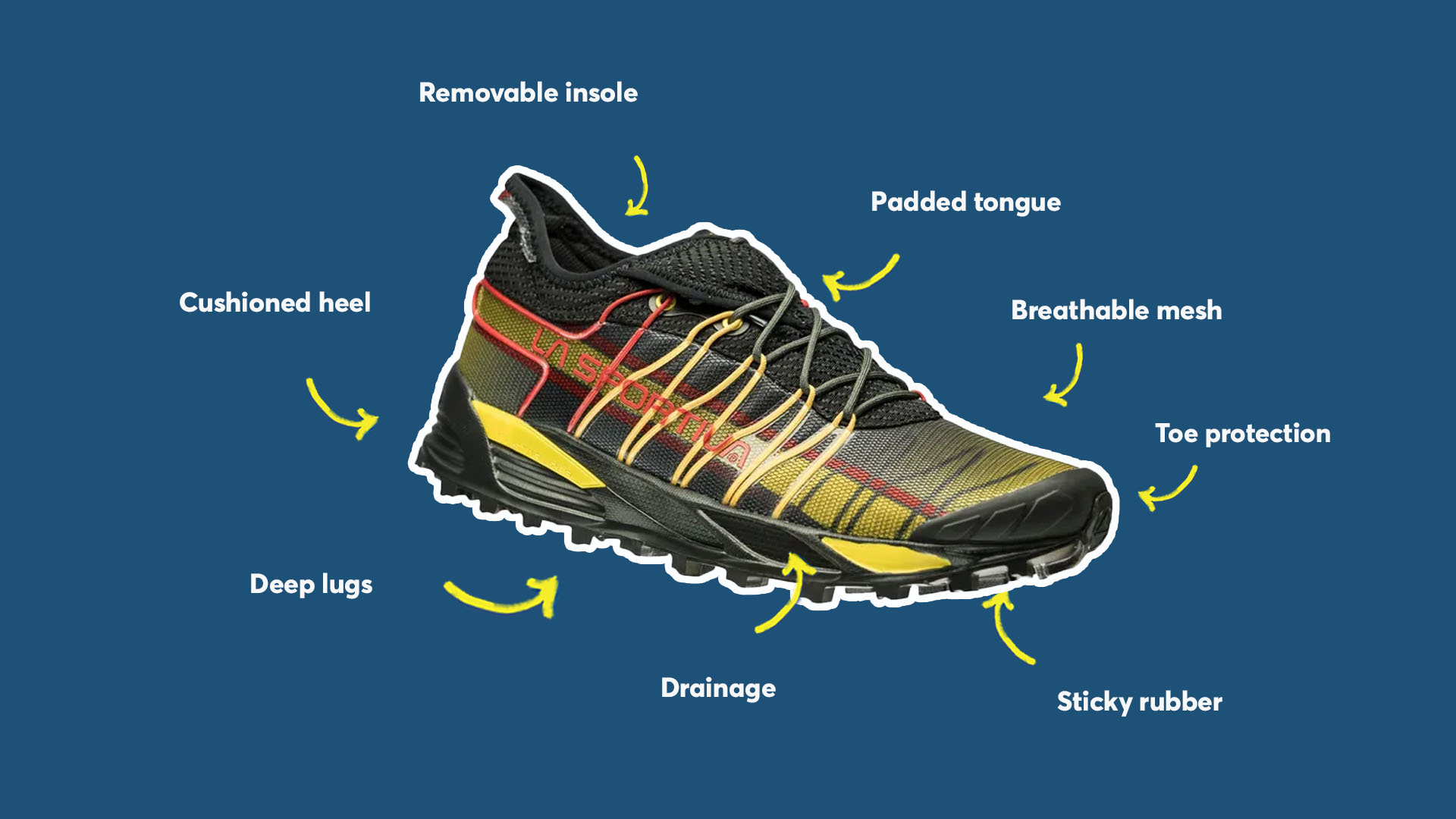
Another issue can be when the lugs on an outsole are so deep and so close together that they hold onto mud and become clogged. This then affects the amount of traction you’ll get. The trail shoes in this list are made by reputable trail running brands and all of them will be designed to shed mud, though we’d argue that some will be better than others on slippery fells. Inov-8 is a brand that’s well known for creating ultra grippy shoes. La Sportiva and Salomon also have a strong reputation there.
Some trail shoe outsoles look aggressive but are made of tough rubber, meaning they’re great on muddy paths, but they’ll be like ice skates on wet, steep roads or chalk. With that in mind, it’s worth looking into the characteristics of the rubber compound that’s used. Some brands, like Saucony and Salomon, will state whether the rubber compound is made for soft trails or hard ones. A soft, squeezy rubber is usually a sign that the shoes will grip on hard surfaces, while firm rubber will tend to provide the most traction on soft trails.
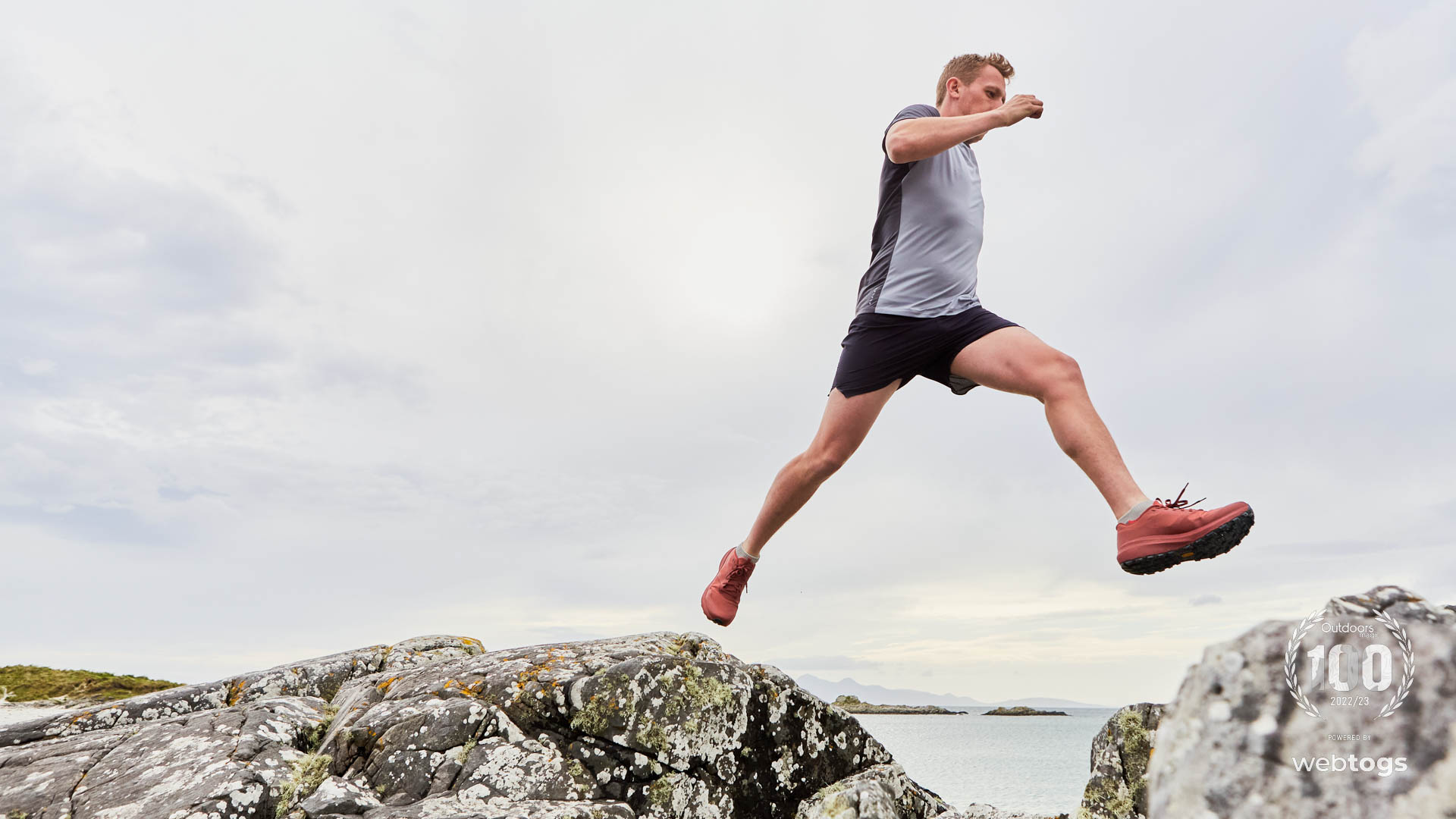
Proprioception
Proprioception, crucial in trail running shoes, refers to the body’s innate sense of spatial awareness and movement, aiding runners in navigating varied terrains with enhanced balance and control.
When running, your feet and toes are constantly making tiny adjustments to help your balance. If there’s a hard and thick sole, and one that doesn’t twist torsionally, then the effect of your toes on your balance could be quite negligible. Somehow, the result can be a feeling of instability, making you lose that much-needed confidence.
Related: Best Trail Running Packs
Related: Best Trail Running Caps
Compare, for example, your walking boots. Apart from being uncomfortable for running, they’d also feel unstable. Good trail running shoes should allow you to feel the ground and have enough space to let your toes work. Some of the examples here will enable the foot to be very close to the ground meaning the foot can balance well. The negative is that you’ll feel more of the stones and roots.
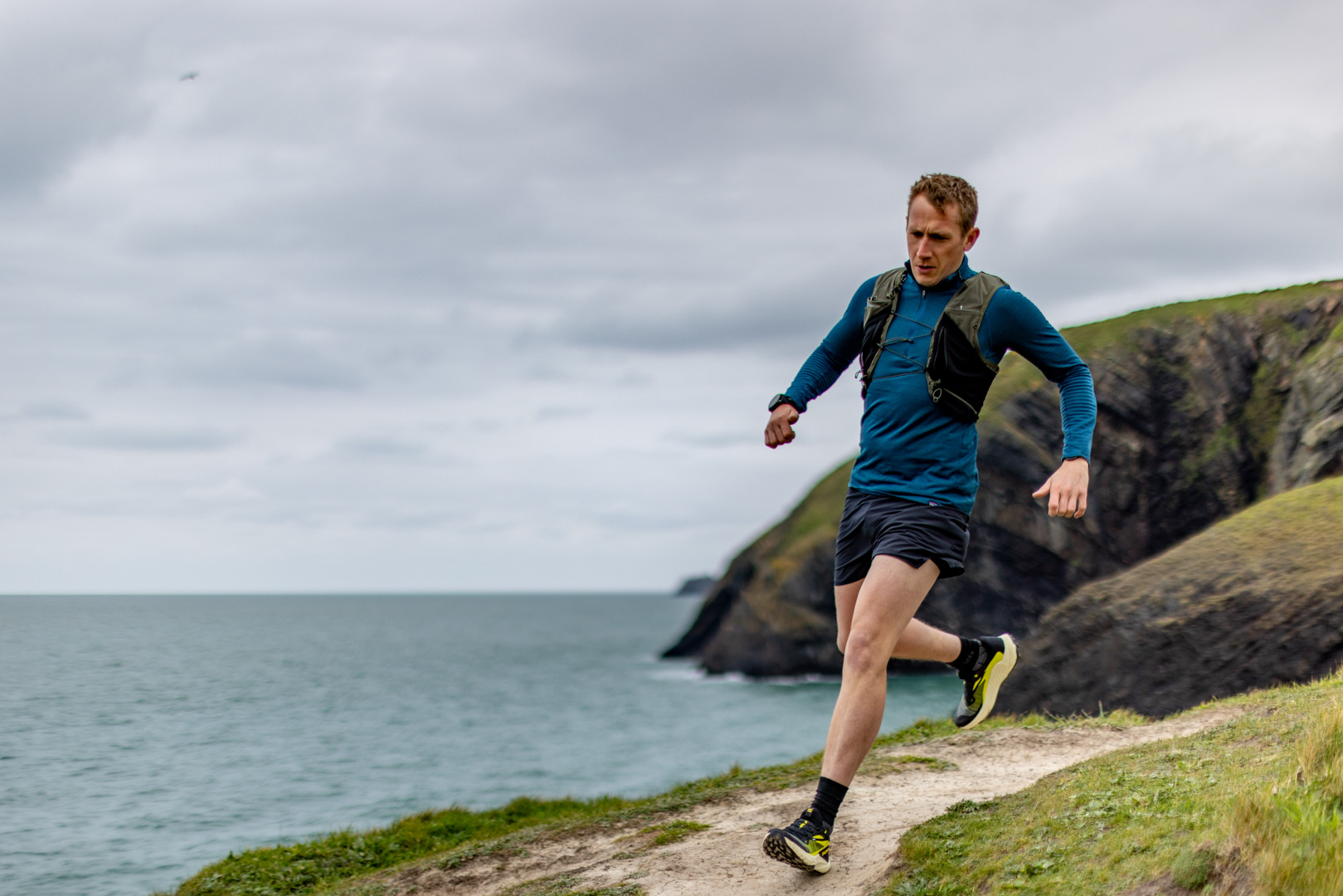
Waterproof Versus Non-Waterproof
Generally speaking, running in waterproof trail running shoes isn’t ideal. First of all, that’s because when you’re going at tempo you’re going to what something that provides as much breathability as possible, and membrane-lined shoes can get clammy when you’re really working hard. There’s also then the fact that water can easily get into trail running shoes when conditions are wet and, with waterproof shoes, once that moisture gets in then it tends to stay in. With non-lined shoes, when that moisture gets in, at least it can get out and your feet can dry out as soon as the conditions get drier.
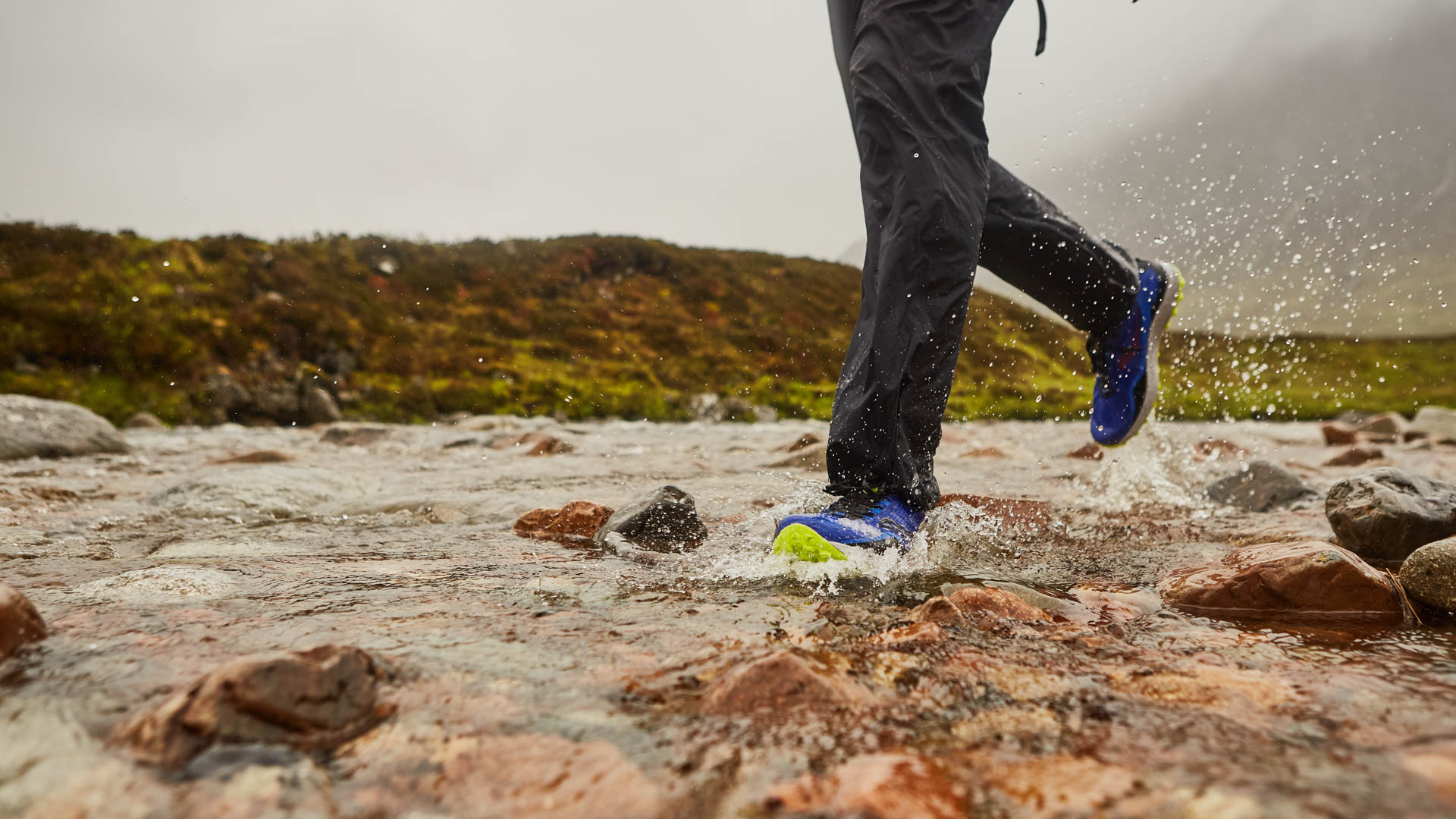
Still, that’s only generally speaking. There are conditions where waterproof shoes might be beneficial. On short runs in cold weather and when there’s no risk of water creeping in at the ankle, waterproof trail running shoes can be great. The thing is, depending on where you are, those conditions might not come about too often – certainly not in the UK where we conducted our tests of these shoes!
What Does ‘Stack Height’ Mean On Trail Running Shoes?
It’s easy for trail running brands to throw ‘stack height’ and ‘drop’ numbers at you, without explanation of what they influence, so we’re here to put that straight.
Firstly, stack height represents the thickness of the midsole at both the toe and heel. With the modern-day polarisation between highly cushioned and barefoot running shoes, this number is becoming an increasingly important stat that’ll show how the shoe will likely behave. Put simply, shoes with high stack heights will be more cushioned, but less responsive due to little underfoot feel. Low height shoes will be less cushioned, but will have greater stability and feel underfoot.
The amount of stack height you choose is of course all down to personal preference.
What Does ‘Drop’ Mean On Trail Running Shoes?
The difference in stack height between the heel and toe is what’s known as ‘the drop’. A 0mm drop, for example, would have the heel and the ball at the same level – as you would barefoot. In recent years, ‘barefoot running’, where people run in shoes with a very low stack height, has become extremely popular. The drop can be anything between 12mm and 0mm. Anything below 5mm would be considered a ‘low-drop’ trail running shoe.
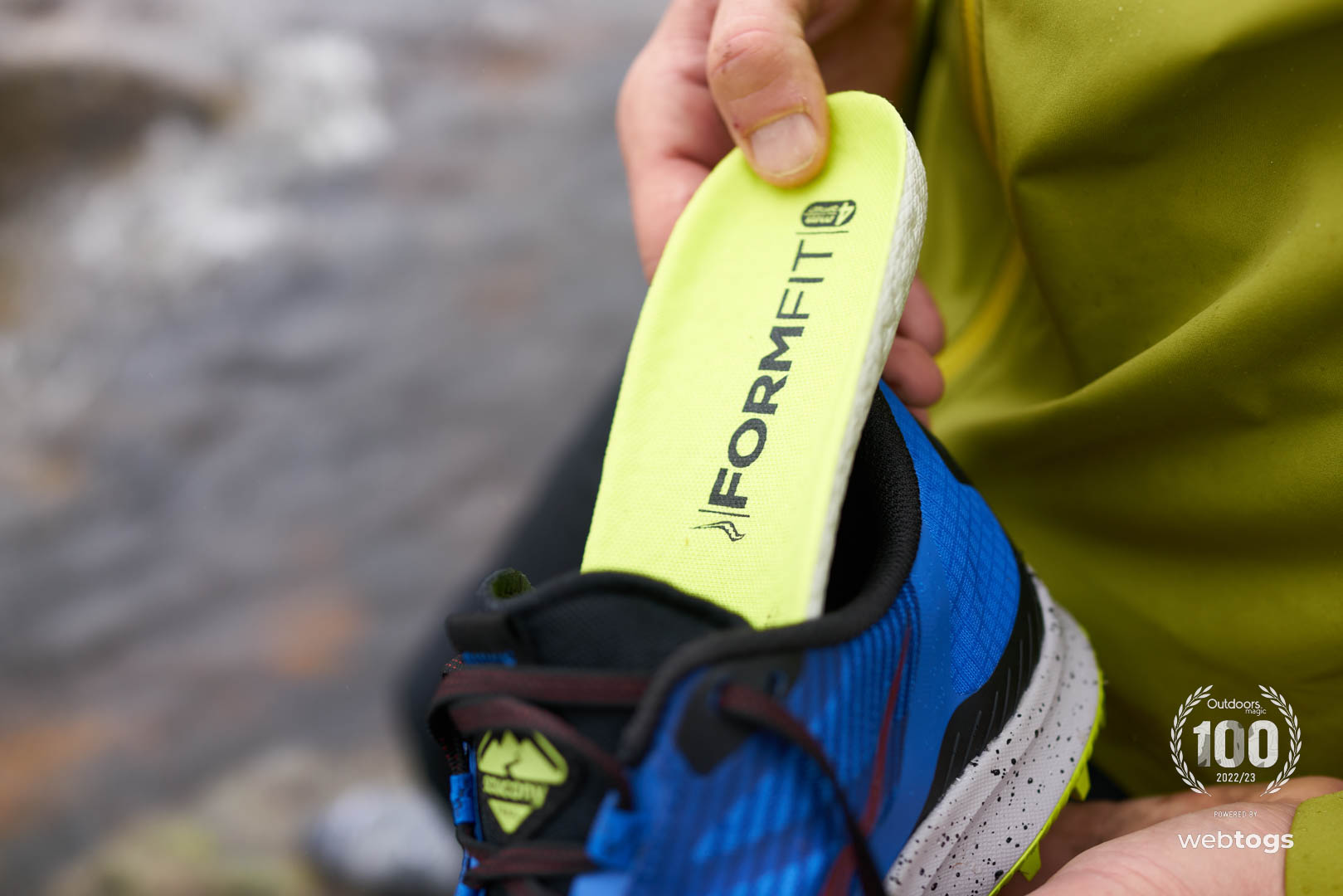
The drop of the shoe affects how your foot strikes the ground whilst running. High drop (8 mm+) shoes promote a heel strike (due to the cushioning in the heel), while low-mid drop (- 8mm) promote a mid-forefoot strike.
It’s important to remember that stack height and drop are independent of each other. Depending on your preferred gait, you could find high stack height trail shoes that still have a zero or low heel-to-toe drop.

